Impact of Brand Image and Product Design on Consumer Behavior in the Snowboarding Market: A Dissertation Study
VerifiedAdded on 2023/04/25
|30
|8293
|295
AI Summary
This dissertation examines the influence of brand image and product design on consumer behavior in the snowboarding market. It addresses the issues with product design, such as durability and ease of use, which negatively impact brand image. The study aims to understand the concepts of brand image, product design, and consumer behavior, evaluate factors affecting brand image and product design, and investigate their impact on consumer behavior in the snowboarding market.
Contribute Materials
Your contribution can guide someone’s learning journey. Share your
documents today.
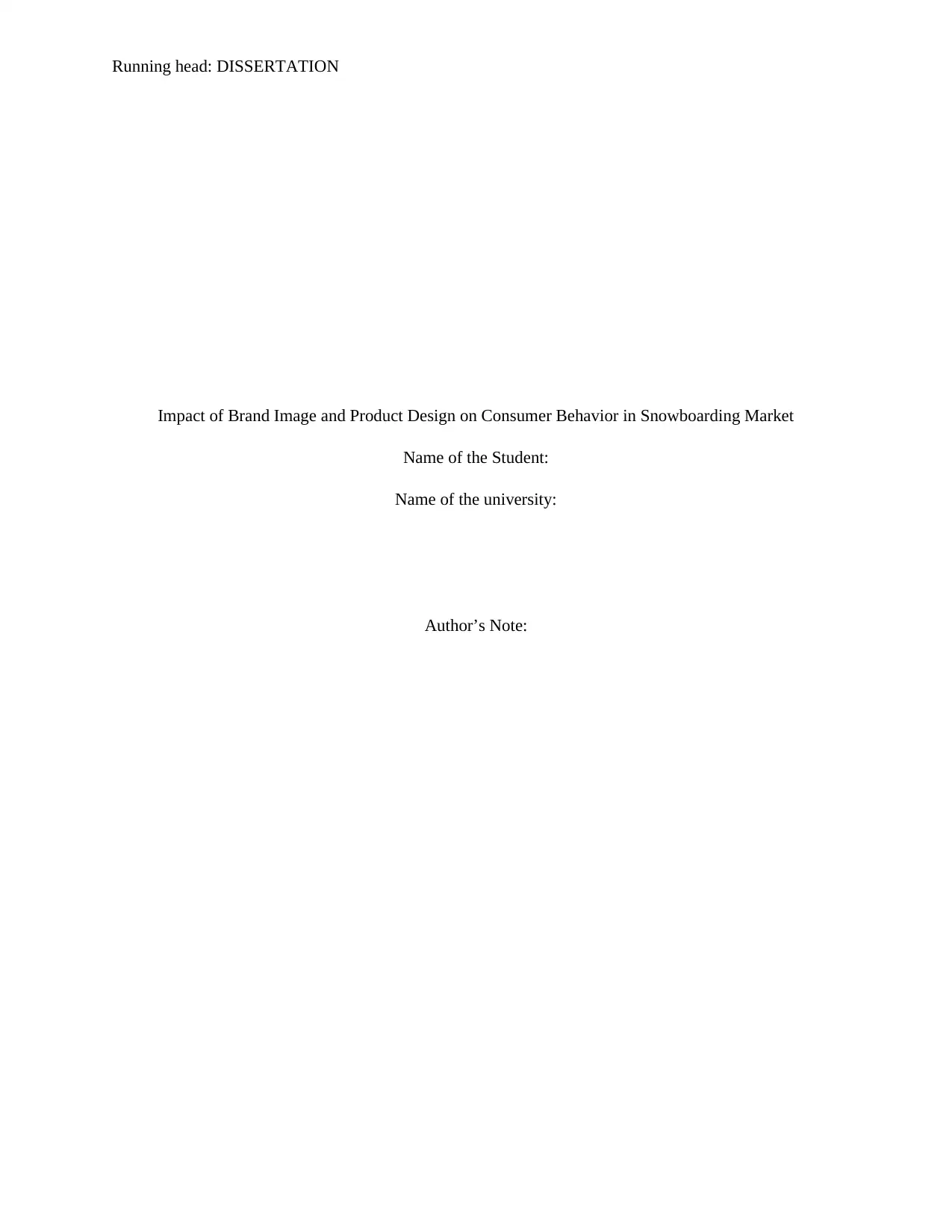
Running head: DISSERTATION
Impact of Brand Image and Product Design on Consumer Behavior in Snowboarding Market
Name of the Student:
Name of the university:
Author’s Note:
Impact of Brand Image and Product Design on Consumer Behavior in Snowboarding Market
Name of the Student:
Name of the university:
Author’s Note:
Secure Best Marks with AI Grader
Need help grading? Try our AI Grader for instant feedback on your assignments.
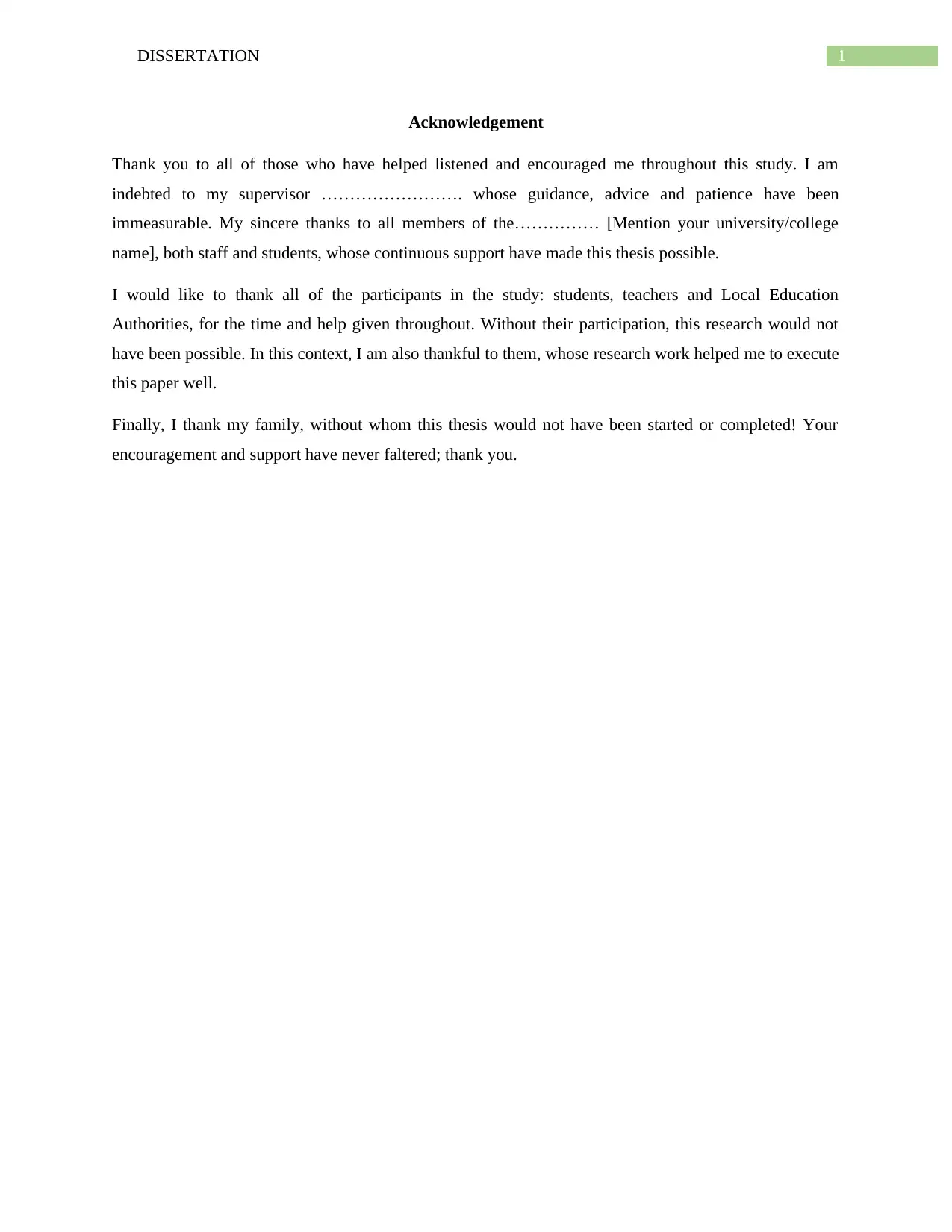
1DISSERTATION
Acknowledgement
Thank you to all of those who have helped listened and encouraged me throughout this study. I am
indebted to my supervisor ……………………. whose guidance, advice and patience have been
immeasurable. My sincere thanks to all members of the…………… [Mention your university/college
name], both staff and students, whose continuous support have made this thesis possible.
I would like to thank all of the participants in the study: students, teachers and Local Education
Authorities, for the time and help given throughout. Without their participation, this research would not
have been possible. In this context, I am also thankful to them, whose research work helped me to execute
this paper well.
Finally, I thank my family, without whom this thesis would not have been started or completed! Your
encouragement and support have never faltered; thank you.
Acknowledgement
Thank you to all of those who have helped listened and encouraged me throughout this study. I am
indebted to my supervisor ……………………. whose guidance, advice and patience have been
immeasurable. My sincere thanks to all members of the…………… [Mention your university/college
name], both staff and students, whose continuous support have made this thesis possible.
I would like to thank all of the participants in the study: students, teachers and Local Education
Authorities, for the time and help given throughout. Without their participation, this research would not
have been possible. In this context, I am also thankful to them, whose research work helped me to execute
this paper well.
Finally, I thank my family, without whom this thesis would not have been started or completed! Your
encouragement and support have never faltered; thank you.
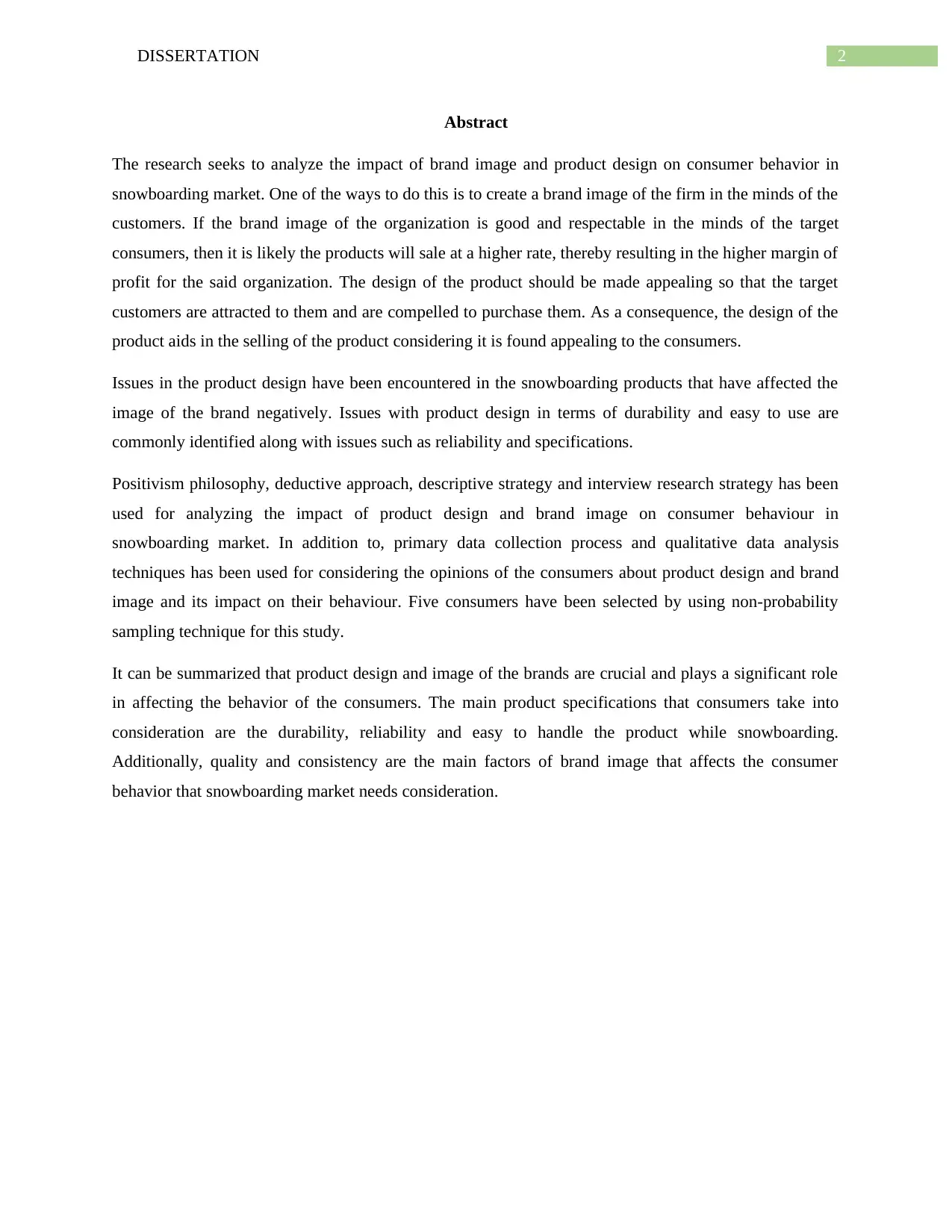
2DISSERTATION
Abstract
The research seeks to analyze the impact of brand image and product design on consumer behavior in
snowboarding market. One of the ways to do this is to create a brand image of the firm in the minds of the
customers. If the brand image of the organization is good and respectable in the minds of the target
consumers, then it is likely the products will sale at a higher rate, thereby resulting in the higher margin of
profit for the said organization. The design of the product should be made appealing so that the target
customers are attracted to them and are compelled to purchase them. As a consequence, the design of the
product aids in the selling of the product considering it is found appealing to the consumers.
Issues in the product design have been encountered in the snowboarding products that have affected the
image of the brand negatively. Issues with product design in terms of durability and easy to use are
commonly identified along with issues such as reliability and specifications.
Positivism philosophy, deductive approach, descriptive strategy and interview research strategy has been
used for analyzing the impact of product design and brand image on consumer behaviour in
snowboarding market. In addition to, primary data collection process and qualitative data analysis
techniques has been used for considering the opinions of the consumers about product design and brand
image and its impact on their behaviour. Five consumers have been selected by using non-probability
sampling technique for this study.
It can be summarized that product design and image of the brands are crucial and plays a significant role
in affecting the behavior of the consumers. The main product specifications that consumers take into
consideration are the durability, reliability and easy to handle the product while snowboarding.
Additionally, quality and consistency are the main factors of brand image that affects the consumer
behavior that snowboarding market needs consideration.
Abstract
The research seeks to analyze the impact of brand image and product design on consumer behavior in
snowboarding market. One of the ways to do this is to create a brand image of the firm in the minds of the
customers. If the brand image of the organization is good and respectable in the minds of the target
consumers, then it is likely the products will sale at a higher rate, thereby resulting in the higher margin of
profit for the said organization. The design of the product should be made appealing so that the target
customers are attracted to them and are compelled to purchase them. As a consequence, the design of the
product aids in the selling of the product considering it is found appealing to the consumers.
Issues in the product design have been encountered in the snowboarding products that have affected the
image of the brand negatively. Issues with product design in terms of durability and easy to use are
commonly identified along with issues such as reliability and specifications.
Positivism philosophy, deductive approach, descriptive strategy and interview research strategy has been
used for analyzing the impact of product design and brand image on consumer behaviour in
snowboarding market. In addition to, primary data collection process and qualitative data analysis
techniques has been used for considering the opinions of the consumers about product design and brand
image and its impact on their behaviour. Five consumers have been selected by using non-probability
sampling technique for this study.
It can be summarized that product design and image of the brands are crucial and plays a significant role
in affecting the behavior of the consumers. The main product specifications that consumers take into
consideration are the durability, reliability and easy to handle the product while snowboarding.
Additionally, quality and consistency are the main factors of brand image that affects the consumer
behavior that snowboarding market needs consideration.
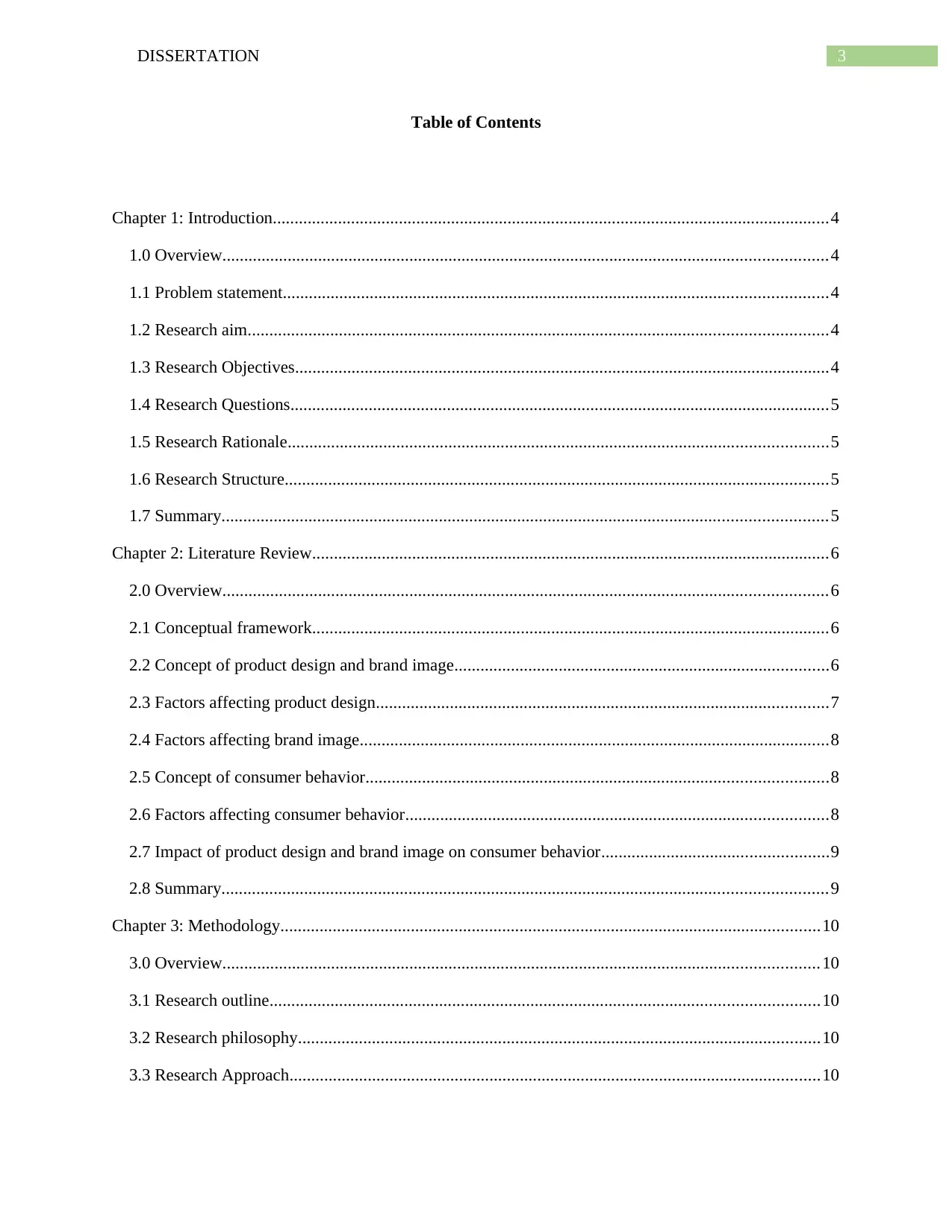
3DISSERTATION
Table of Contents
Chapter 1: Introduction................................................................................................................................4
1.0 Overview...........................................................................................................................................4
1.1 Problem statement.............................................................................................................................4
1.2 Research aim.....................................................................................................................................4
1.3 Research Objectives...........................................................................................................................4
1.4 Research Questions............................................................................................................................5
1.5 Research Rationale............................................................................................................................5
1.6 Research Structure.............................................................................................................................5
1.7 Summary...........................................................................................................................................5
Chapter 2: Literature Review.......................................................................................................................6
2.0 Overview...........................................................................................................................................6
2.1 Conceptual framework.......................................................................................................................6
2.2 Concept of product design and brand image......................................................................................6
2.3 Factors affecting product design........................................................................................................7
2.4 Factors affecting brand image............................................................................................................8
2.5 Concept of consumer behavior..........................................................................................................8
2.6 Factors affecting consumer behavior.................................................................................................8
2.7 Impact of product design and brand image on consumer behavior....................................................9
2.8 Summary...........................................................................................................................................9
Chapter 3: Methodology............................................................................................................................10
3.0 Overview.........................................................................................................................................10
3.1 Research outline..............................................................................................................................10
3.2 Research philosophy........................................................................................................................10
3.3 Research Approach..........................................................................................................................10
Table of Contents
Chapter 1: Introduction................................................................................................................................4
1.0 Overview...........................................................................................................................................4
1.1 Problem statement.............................................................................................................................4
1.2 Research aim.....................................................................................................................................4
1.3 Research Objectives...........................................................................................................................4
1.4 Research Questions............................................................................................................................5
1.5 Research Rationale............................................................................................................................5
1.6 Research Structure.............................................................................................................................5
1.7 Summary...........................................................................................................................................5
Chapter 2: Literature Review.......................................................................................................................6
2.0 Overview...........................................................................................................................................6
2.1 Conceptual framework.......................................................................................................................6
2.2 Concept of product design and brand image......................................................................................6
2.3 Factors affecting product design........................................................................................................7
2.4 Factors affecting brand image............................................................................................................8
2.5 Concept of consumer behavior..........................................................................................................8
2.6 Factors affecting consumer behavior.................................................................................................8
2.7 Impact of product design and brand image on consumer behavior....................................................9
2.8 Summary...........................................................................................................................................9
Chapter 3: Methodology............................................................................................................................10
3.0 Overview.........................................................................................................................................10
3.1 Research outline..............................................................................................................................10
3.2 Research philosophy........................................................................................................................10
3.3 Research Approach..........................................................................................................................10
Secure Best Marks with AI Grader
Need help grading? Try our AI Grader for instant feedback on your assignments.
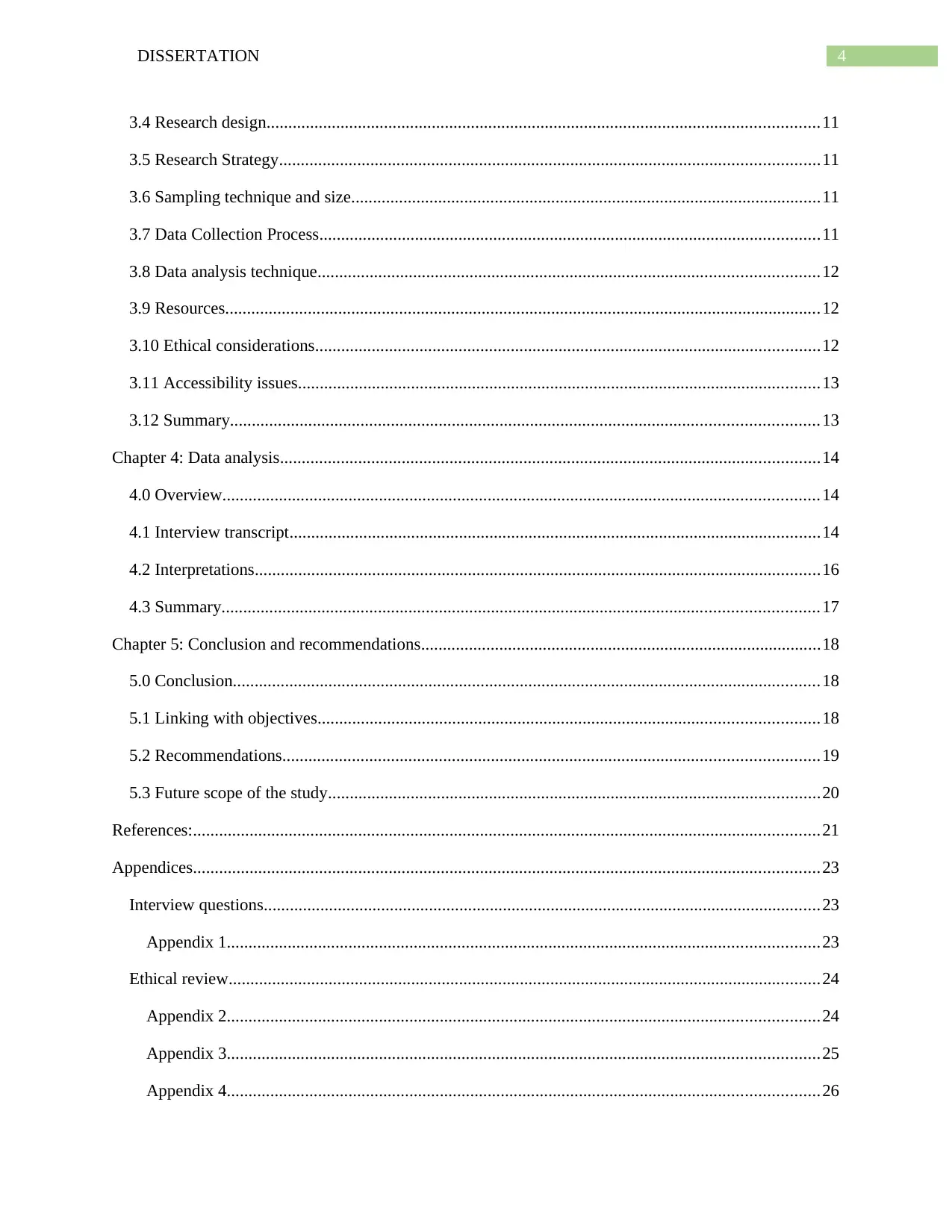
4DISSERTATION
3.4 Research design...............................................................................................................................11
3.5 Research Strategy............................................................................................................................11
3.6 Sampling technique and size............................................................................................................11
3.7 Data Collection Process...................................................................................................................11
3.8 Data analysis technique...................................................................................................................12
3.9 Resources.........................................................................................................................................12
3.10 Ethical considerations....................................................................................................................12
3.11 Accessibility issues........................................................................................................................13
3.12 Summary.......................................................................................................................................13
Chapter 4: Data analysis............................................................................................................................14
4.0 Overview.........................................................................................................................................14
4.1 Interview transcript..........................................................................................................................14
4.2 Interpretations..................................................................................................................................16
4.3 Summary.........................................................................................................................................17
Chapter 5: Conclusion and recommendations............................................................................................18
5.0 Conclusion.......................................................................................................................................18
5.1 Linking with objectives...................................................................................................................18
5.2 Recommendations...........................................................................................................................19
5.3 Future scope of the study.................................................................................................................20
References:................................................................................................................................................21
Appendices................................................................................................................................................23
Interview questions................................................................................................................................23
Appendix 1........................................................................................................................................23
Ethical review........................................................................................................................................24
Appendix 2........................................................................................................................................24
Appendix 3........................................................................................................................................25
Appendix 4........................................................................................................................................26
3.4 Research design...............................................................................................................................11
3.5 Research Strategy............................................................................................................................11
3.6 Sampling technique and size............................................................................................................11
3.7 Data Collection Process...................................................................................................................11
3.8 Data analysis technique...................................................................................................................12
3.9 Resources.........................................................................................................................................12
3.10 Ethical considerations....................................................................................................................12
3.11 Accessibility issues........................................................................................................................13
3.12 Summary.......................................................................................................................................13
Chapter 4: Data analysis............................................................................................................................14
4.0 Overview.........................................................................................................................................14
4.1 Interview transcript..........................................................................................................................14
4.2 Interpretations..................................................................................................................................16
4.3 Summary.........................................................................................................................................17
Chapter 5: Conclusion and recommendations............................................................................................18
5.0 Conclusion.......................................................................................................................................18
5.1 Linking with objectives...................................................................................................................18
5.2 Recommendations...........................................................................................................................19
5.3 Future scope of the study.................................................................................................................20
References:................................................................................................................................................21
Appendices................................................................................................................................................23
Interview questions................................................................................................................................23
Appendix 1........................................................................................................................................23
Ethical review........................................................................................................................................24
Appendix 2........................................................................................................................................24
Appendix 3........................................................................................................................................25
Appendix 4........................................................................................................................................26

5DISSERTATION
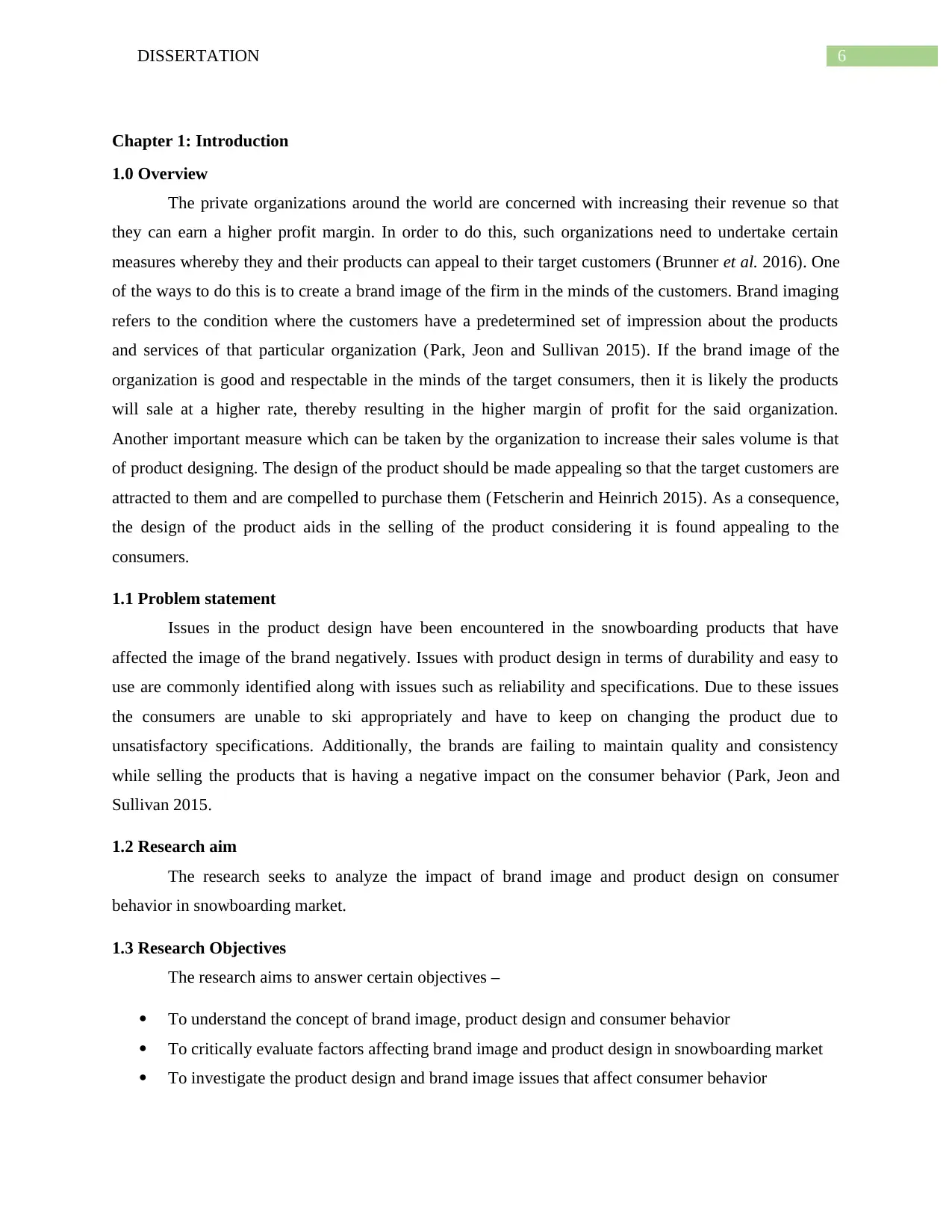
6DISSERTATION
Chapter 1: Introduction
1.0 Overview
The private organizations around the world are concerned with increasing their revenue so that
they can earn a higher profit margin. In order to do this, such organizations need to undertake certain
measures whereby they and their products can appeal to their target customers (Brunner et al. 2016). One
of the ways to do this is to create a brand image of the firm in the minds of the customers. Brand imaging
refers to the condition where the customers have a predetermined set of impression about the products
and services of that particular organization (Park, Jeon and Sullivan 2015). If the brand image of the
organization is good and respectable in the minds of the target consumers, then it is likely the products
will sale at a higher rate, thereby resulting in the higher margin of profit for the said organization.
Another important measure which can be taken by the organization to increase their sales volume is that
of product designing. The design of the product should be made appealing so that the target customers are
attracted to them and are compelled to purchase them (Fetscherin and Heinrich 2015). As a consequence,
the design of the product aids in the selling of the product considering it is found appealing to the
consumers.
1.1 Problem statement
Issues in the product design have been encountered in the snowboarding products that have
affected the image of the brand negatively. Issues with product design in terms of durability and easy to
use are commonly identified along with issues such as reliability and specifications. Due to these issues
the consumers are unable to ski appropriately and have to keep on changing the product due to
unsatisfactory specifications. Additionally, the brands are failing to maintain quality and consistency
while selling the products that is having a negative impact on the consumer behavior ( Park, Jeon and
Sullivan 2015.
1.2 Research aim
The research seeks to analyze the impact of brand image and product design on consumer
behavior in snowboarding market.
1.3 Research Objectives
The research aims to answer certain objectives –
To understand the concept of brand image, product design and consumer behavior
To critically evaluate factors affecting brand image and product design in snowboarding market
To investigate the product design and brand image issues that affect consumer behavior
Chapter 1: Introduction
1.0 Overview
The private organizations around the world are concerned with increasing their revenue so that
they can earn a higher profit margin. In order to do this, such organizations need to undertake certain
measures whereby they and their products can appeal to their target customers (Brunner et al. 2016). One
of the ways to do this is to create a brand image of the firm in the minds of the customers. Brand imaging
refers to the condition where the customers have a predetermined set of impression about the products
and services of that particular organization (Park, Jeon and Sullivan 2015). If the brand image of the
organization is good and respectable in the minds of the target consumers, then it is likely the products
will sale at a higher rate, thereby resulting in the higher margin of profit for the said organization.
Another important measure which can be taken by the organization to increase their sales volume is that
of product designing. The design of the product should be made appealing so that the target customers are
attracted to them and are compelled to purchase them (Fetscherin and Heinrich 2015). As a consequence,
the design of the product aids in the selling of the product considering it is found appealing to the
consumers.
1.1 Problem statement
Issues in the product design have been encountered in the snowboarding products that have
affected the image of the brand negatively. Issues with product design in terms of durability and easy to
use are commonly identified along with issues such as reliability and specifications. Due to these issues
the consumers are unable to ski appropriately and have to keep on changing the product due to
unsatisfactory specifications. Additionally, the brands are failing to maintain quality and consistency
while selling the products that is having a negative impact on the consumer behavior ( Park, Jeon and
Sullivan 2015.
1.2 Research aim
The research seeks to analyze the impact of brand image and product design on consumer
behavior in snowboarding market.
1.3 Research Objectives
The research aims to answer certain objectives –
To understand the concept of brand image, product design and consumer behavior
To critically evaluate factors affecting brand image and product design in snowboarding market
To investigate the product design and brand image issues that affect consumer behavior
Paraphrase This Document
Need a fresh take? Get an instant paraphrase of this document with our AI Paraphraser
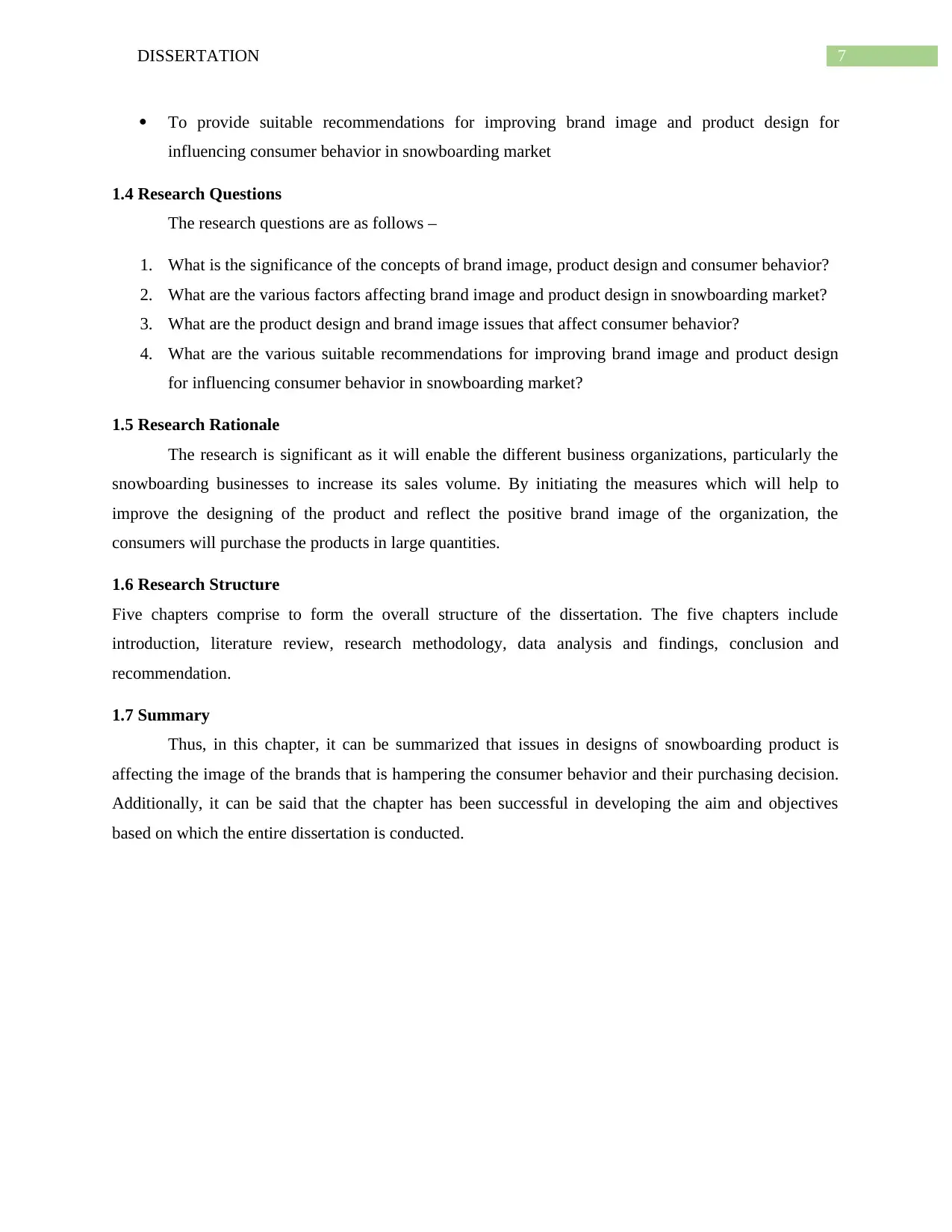
7DISSERTATION
To provide suitable recommendations for improving brand image and product design for
influencing consumer behavior in snowboarding market
1.4 Research Questions
The research questions are as follows –
1. What is the significance of the concepts of brand image, product design and consumer behavior?
2. What are the various factors affecting brand image and product design in snowboarding market?
3. What are the product design and brand image issues that affect consumer behavior?
4. What are the various suitable recommendations for improving brand image and product design
for influencing consumer behavior in snowboarding market?
1.5 Research Rationale
The research is significant as it will enable the different business organizations, particularly the
snowboarding businesses to increase its sales volume. By initiating the measures which will help to
improve the designing of the product and reflect the positive brand image of the organization, the
consumers will purchase the products in large quantities.
1.6 Research Structure
Five chapters comprise to form the overall structure of the dissertation. The five chapters include
introduction, literature review, research methodology, data analysis and findings, conclusion and
recommendation.
1.7 Summary
Thus, in this chapter, it can be summarized that issues in designs of snowboarding product is
affecting the image of the brands that is hampering the consumer behavior and their purchasing decision.
Additionally, it can be said that the chapter has been successful in developing the aim and objectives
based on which the entire dissertation is conducted.
To provide suitable recommendations for improving brand image and product design for
influencing consumer behavior in snowboarding market
1.4 Research Questions
The research questions are as follows –
1. What is the significance of the concepts of brand image, product design and consumer behavior?
2. What are the various factors affecting brand image and product design in snowboarding market?
3. What are the product design and brand image issues that affect consumer behavior?
4. What are the various suitable recommendations for improving brand image and product design
for influencing consumer behavior in snowboarding market?
1.5 Research Rationale
The research is significant as it will enable the different business organizations, particularly the
snowboarding businesses to increase its sales volume. By initiating the measures which will help to
improve the designing of the product and reflect the positive brand image of the organization, the
consumers will purchase the products in large quantities.
1.6 Research Structure
Five chapters comprise to form the overall structure of the dissertation. The five chapters include
introduction, literature review, research methodology, data analysis and findings, conclusion and
recommendation.
1.7 Summary
Thus, in this chapter, it can be summarized that issues in designs of snowboarding product is
affecting the image of the brands that is hampering the consumer behavior and their purchasing decision.
Additionally, it can be said that the chapter has been successful in developing the aim and objectives
based on which the entire dissertation is conducted.
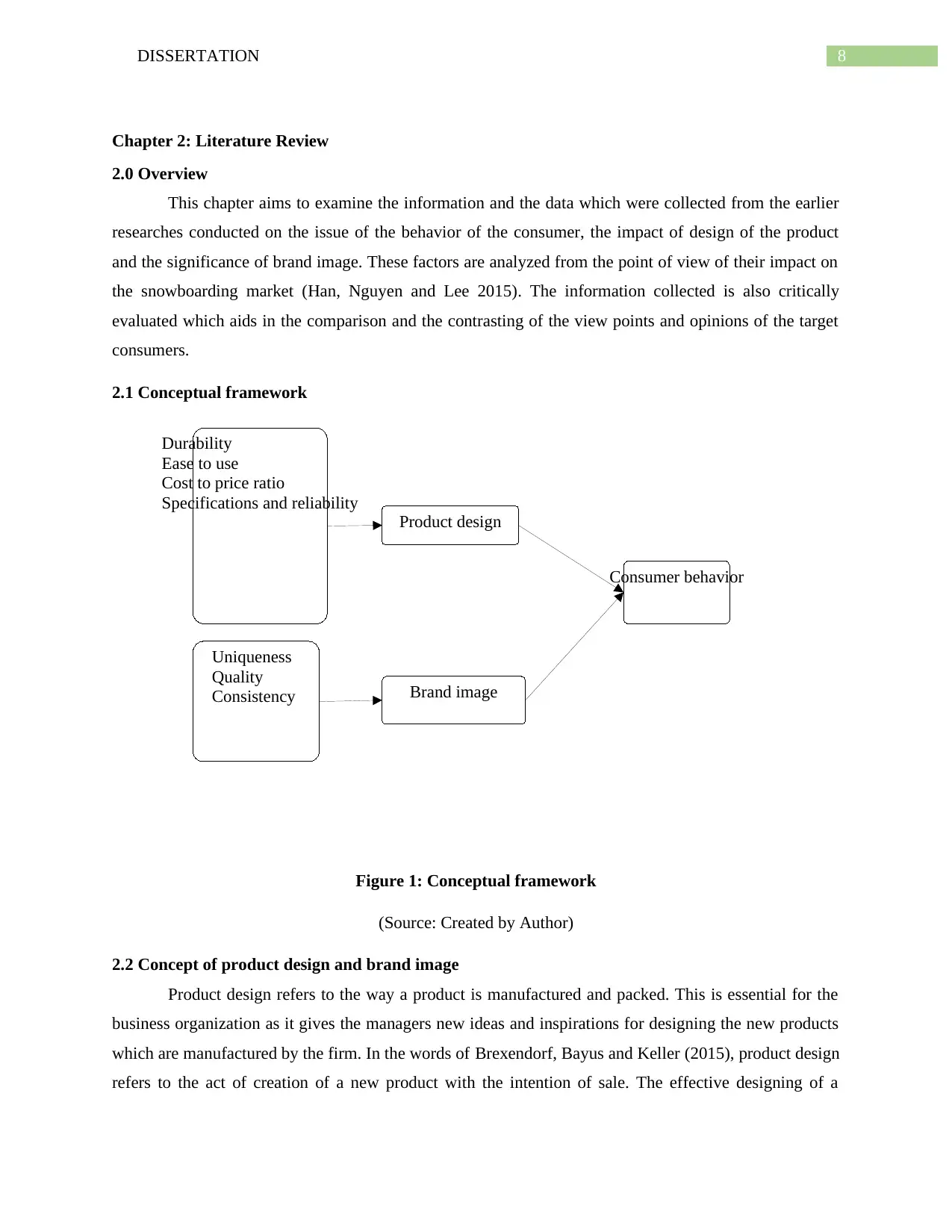
8DISSERTATION
Product design
Durability
Ease to use
Cost to price ratio
Specifications and reliability
Brand image
Uniqueness
Quality
Consistency
Consumer behavior
Chapter 2: Literature Review
2.0 Overview
This chapter aims to examine the information and the data which were collected from the earlier
researches conducted on the issue of the behavior of the consumer, the impact of design of the product
and the significance of brand image. These factors are analyzed from the point of view of their impact on
the snowboarding market (Han, Nguyen and Lee 2015). The information collected is also critically
evaluated which aids in the comparison and the contrasting of the view points and opinions of the target
consumers.
2.1 Conceptual framework
Figure 1: Conceptual framework
(Source: Created by Author)
2.2 Concept of product design and brand image
Product design refers to the way a product is manufactured and packed. This is essential for the
business organization as it gives the managers new ideas and inspirations for designing the new products
which are manufactured by the firm. In the words of Brexendorf, Bayus and Keller (2015), product design
refers to the act of creation of a new product with the intention of sale. The effective designing of a
Product design
Durability
Ease to use
Cost to price ratio
Specifications and reliability
Brand image
Uniqueness
Quality
Consistency
Consumer behavior
Chapter 2: Literature Review
2.0 Overview
This chapter aims to examine the information and the data which were collected from the earlier
researches conducted on the issue of the behavior of the consumer, the impact of design of the product
and the significance of brand image. These factors are analyzed from the point of view of their impact on
the snowboarding market (Han, Nguyen and Lee 2015). The information collected is also critically
evaluated which aids in the comparison and the contrasting of the view points and opinions of the target
consumers.
2.1 Conceptual framework
Figure 1: Conceptual framework
(Source: Created by Author)
2.2 Concept of product design and brand image
Product design refers to the way a product is manufactured and packed. This is essential for the
business organization as it gives the managers new ideas and inspirations for designing the new products
which are manufactured by the firm. In the words of Brexendorf, Bayus and Keller (2015), product design
refers to the act of creation of a new product with the intention of sale. The effective designing of a
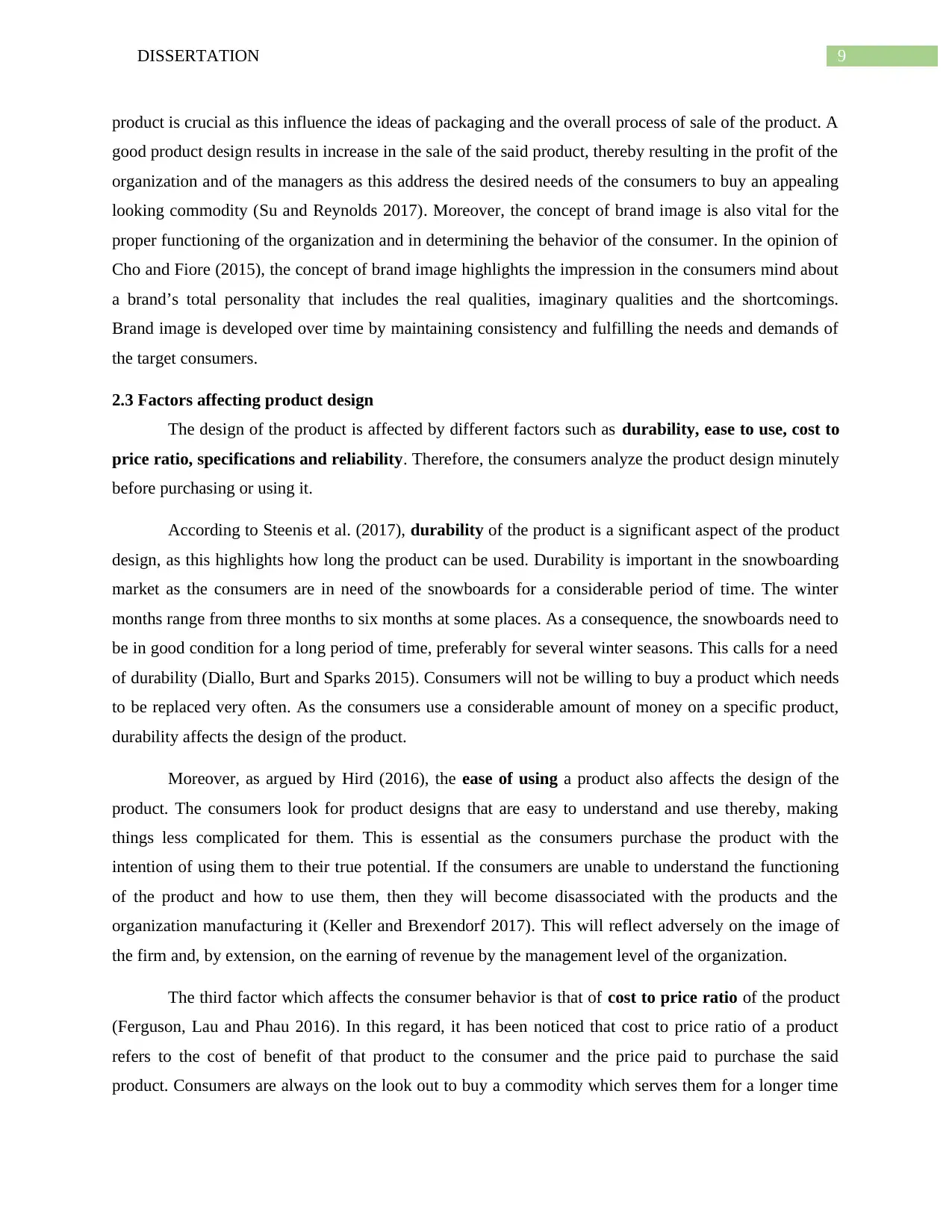
9DISSERTATION
product is crucial as this influence the ideas of packaging and the overall process of sale of the product. A
good product design results in increase in the sale of the said product, thereby resulting in the profit of the
organization and of the managers as this address the desired needs of the consumers to buy an appealing
looking commodity (Su and Reynolds 2017). Moreover, the concept of brand image is also vital for the
proper functioning of the organization and in determining the behavior of the consumer. In the opinion of
Cho and Fiore (2015), the concept of brand image highlights the impression in the consumers mind about
a brand’s total personality that includes the real qualities, imaginary qualities and the shortcomings.
Brand image is developed over time by maintaining consistency and fulfilling the needs and demands of
the target consumers.
2.3 Factors affecting product design
The design of the product is affected by different factors such as durability, ease to use, cost to
price ratio, specifications and reliability. Therefore, the consumers analyze the product design minutely
before purchasing or using it.
According to Steenis et al. (2017), durability of the product is a significant aspect of the product
design, as this highlights how long the product can be used. Durability is important in the snowboarding
market as the consumers are in need of the snowboards for a considerable period of time. The winter
months range from three months to six months at some places. As a consequence, the snowboards need to
be in good condition for a long period of time, preferably for several winter seasons. This calls for a need
of durability (Diallo, Burt and Sparks 2015). Consumers will not be willing to buy a product which needs
to be replaced very often. As the consumers use a considerable amount of money on a specific product,
durability affects the design of the product.
Moreover, as argued by Hird (2016), the ease of using a product also affects the design of the
product. The consumers look for product designs that are easy to understand and use thereby, making
things less complicated for them. This is essential as the consumers purchase the product with the
intention of using them to their true potential. If the consumers are unable to understand the functioning
of the product and how to use them, then they will become disassociated with the products and the
organization manufacturing it (Keller and Brexendorf 2017). This will reflect adversely on the image of
the firm and, by extension, on the earning of revenue by the management level of the organization.
The third factor which affects the consumer behavior is that of cost to price ratio of the product
(Ferguson, Lau and Phau 2016). In this regard, it has been noticed that cost to price ratio of a product
refers to the cost of benefit of that product to the consumer and the price paid to purchase the said
product. Consumers are always on the look out to buy a commodity which serves them for a longer time
product is crucial as this influence the ideas of packaging and the overall process of sale of the product. A
good product design results in increase in the sale of the said product, thereby resulting in the profit of the
organization and of the managers as this address the desired needs of the consumers to buy an appealing
looking commodity (Su and Reynolds 2017). Moreover, the concept of brand image is also vital for the
proper functioning of the organization and in determining the behavior of the consumer. In the opinion of
Cho and Fiore (2015), the concept of brand image highlights the impression in the consumers mind about
a brand’s total personality that includes the real qualities, imaginary qualities and the shortcomings.
Brand image is developed over time by maintaining consistency and fulfilling the needs and demands of
the target consumers.
2.3 Factors affecting product design
The design of the product is affected by different factors such as durability, ease to use, cost to
price ratio, specifications and reliability. Therefore, the consumers analyze the product design minutely
before purchasing or using it.
According to Steenis et al. (2017), durability of the product is a significant aspect of the product
design, as this highlights how long the product can be used. Durability is important in the snowboarding
market as the consumers are in need of the snowboards for a considerable period of time. The winter
months range from three months to six months at some places. As a consequence, the snowboards need to
be in good condition for a long period of time, preferably for several winter seasons. This calls for a need
of durability (Diallo, Burt and Sparks 2015). Consumers will not be willing to buy a product which needs
to be replaced very often. As the consumers use a considerable amount of money on a specific product,
durability affects the design of the product.
Moreover, as argued by Hird (2016), the ease of using a product also affects the design of the
product. The consumers look for product designs that are easy to understand and use thereby, making
things less complicated for them. This is essential as the consumers purchase the product with the
intention of using them to their true potential. If the consumers are unable to understand the functioning
of the product and how to use them, then they will become disassociated with the products and the
organization manufacturing it (Keller and Brexendorf 2017). This will reflect adversely on the image of
the firm and, by extension, on the earning of revenue by the management level of the organization.
The third factor which affects the consumer behavior is that of cost to price ratio of the product
(Ferguson, Lau and Phau 2016). In this regard, it has been noticed that cost to price ratio of a product
refers to the cost of benefit of that product to the consumer and the price paid to purchase the said
product. Consumers are always on the look out to buy a commodity which serves them for a longer time
Secure Best Marks with AI Grader
Need help grading? Try our AI Grader for instant feedback on your assignments.
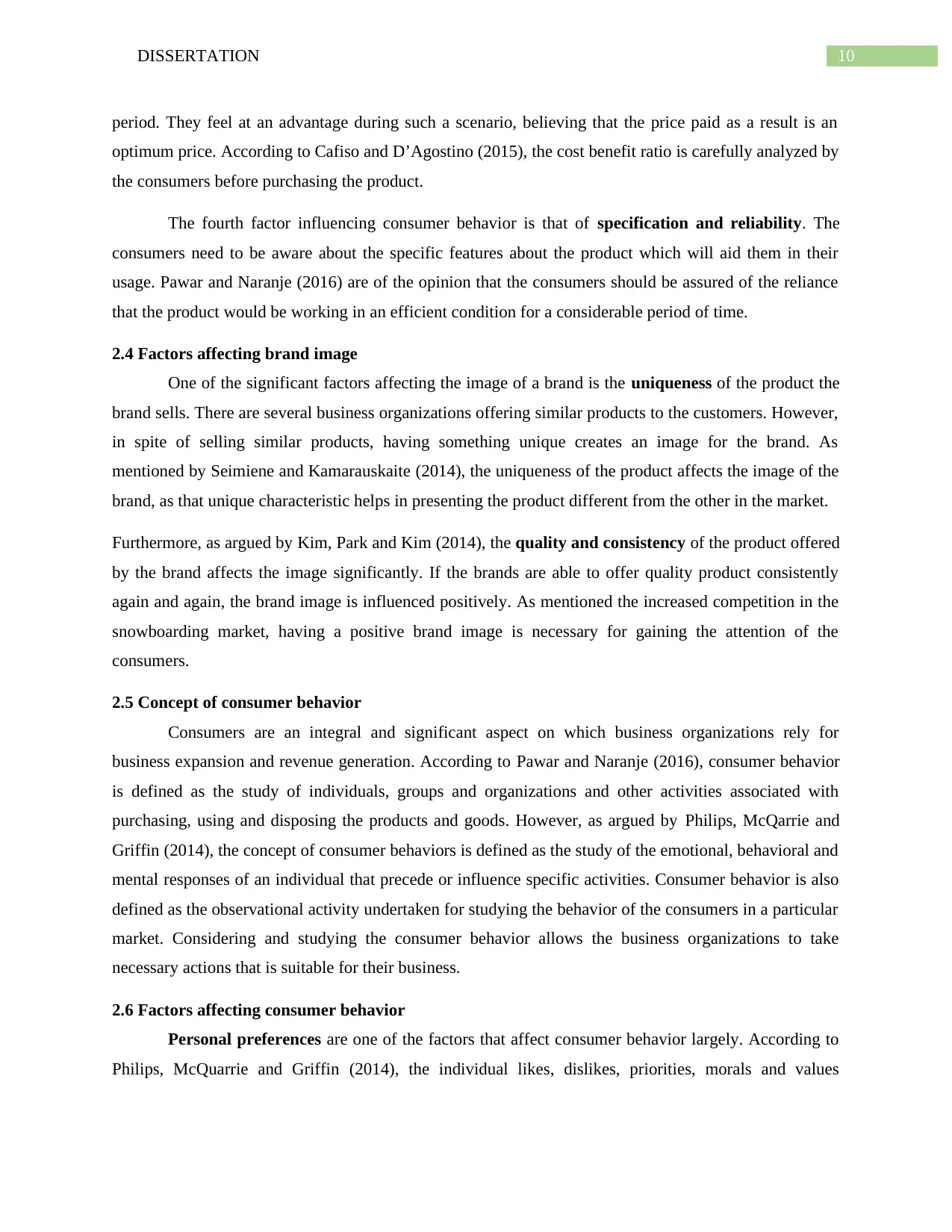
10DISSERTATION
period. They feel at an advantage during such a scenario, believing that the price paid as a result is an
optimum price. According to Cafiso and D’Agostino (2015), the cost benefit ratio is carefully analyzed by
the consumers before purchasing the product.
The fourth factor influencing consumer behavior is that of specification and reliability. The
consumers need to be aware about the specific features about the product which will aid them in their
usage. Pawar and Naranje (2016) are of the opinion that the consumers should be assured of the reliance
that the product would be working in an efficient condition for a considerable period of time.
2.4 Factors affecting brand image
One of the significant factors affecting the image of a brand is the uniqueness of the product the
brand sells. There are several business organizations offering similar products to the customers. However,
in spite of selling similar products, having something unique creates an image for the brand. As
mentioned by Seimiene and Kamarauskaite (2014), the uniqueness of the product affects the image of the
brand, as that unique characteristic helps in presenting the product different from the other in the market.
Furthermore, as argued by Kim, Park and Kim (2014), the quality and consistency of the product offered
by the brand affects the image significantly. If the brands are able to offer quality product consistently
again and again, the brand image is influenced positively. As mentioned the increased competition in the
snowboarding market, having a positive brand image is necessary for gaining the attention of the
consumers.
2.5 Concept of consumer behavior
Consumers are an integral and significant aspect on which business organizations rely for
business expansion and revenue generation. According to Pawar and Naranje (2016), consumer behavior
is defined as the study of individuals, groups and organizations and other activities associated with
purchasing, using and disposing the products and goods. However, as argued by Philips, McQarrie and
Griffin (2014), the concept of consumer behaviors is defined as the study of the emotional, behavioral and
mental responses of an individual that precede or influence specific activities. Consumer behavior is also
defined as the observational activity undertaken for studying the behavior of the consumers in a particular
market. Considering and studying the consumer behavior allows the business organizations to take
necessary actions that is suitable for their business.
2.6 Factors affecting consumer behavior
Personal preferences are one of the factors that affect consumer behavior largely. According to
Philips, McQuarrie and Griffin (2014), the individual likes, dislikes, priorities, morals and values
period. They feel at an advantage during such a scenario, believing that the price paid as a result is an
optimum price. According to Cafiso and D’Agostino (2015), the cost benefit ratio is carefully analyzed by
the consumers before purchasing the product.
The fourth factor influencing consumer behavior is that of specification and reliability. The
consumers need to be aware about the specific features about the product which will aid them in their
usage. Pawar and Naranje (2016) are of the opinion that the consumers should be assured of the reliance
that the product would be working in an efficient condition for a considerable period of time.
2.4 Factors affecting brand image
One of the significant factors affecting the image of a brand is the uniqueness of the product the
brand sells. There are several business organizations offering similar products to the customers. However,
in spite of selling similar products, having something unique creates an image for the brand. As
mentioned by Seimiene and Kamarauskaite (2014), the uniqueness of the product affects the image of the
brand, as that unique characteristic helps in presenting the product different from the other in the market.
Furthermore, as argued by Kim, Park and Kim (2014), the quality and consistency of the product offered
by the brand affects the image significantly. If the brands are able to offer quality product consistently
again and again, the brand image is influenced positively. As mentioned the increased competition in the
snowboarding market, having a positive brand image is necessary for gaining the attention of the
consumers.
2.5 Concept of consumer behavior
Consumers are an integral and significant aspect on which business organizations rely for
business expansion and revenue generation. According to Pawar and Naranje (2016), consumer behavior
is defined as the study of individuals, groups and organizations and other activities associated with
purchasing, using and disposing the products and goods. However, as argued by Philips, McQarrie and
Griffin (2014), the concept of consumer behaviors is defined as the study of the emotional, behavioral and
mental responses of an individual that precede or influence specific activities. Consumer behavior is also
defined as the observational activity undertaken for studying the behavior of the consumers in a particular
market. Considering and studying the consumer behavior allows the business organizations to take
necessary actions that is suitable for their business.
2.6 Factors affecting consumer behavior
Personal preferences are one of the factors that affect consumer behavior largely. According to
Philips, McQuarrie and Griffin (2014), the individual likes, dislikes, priorities, morals and values
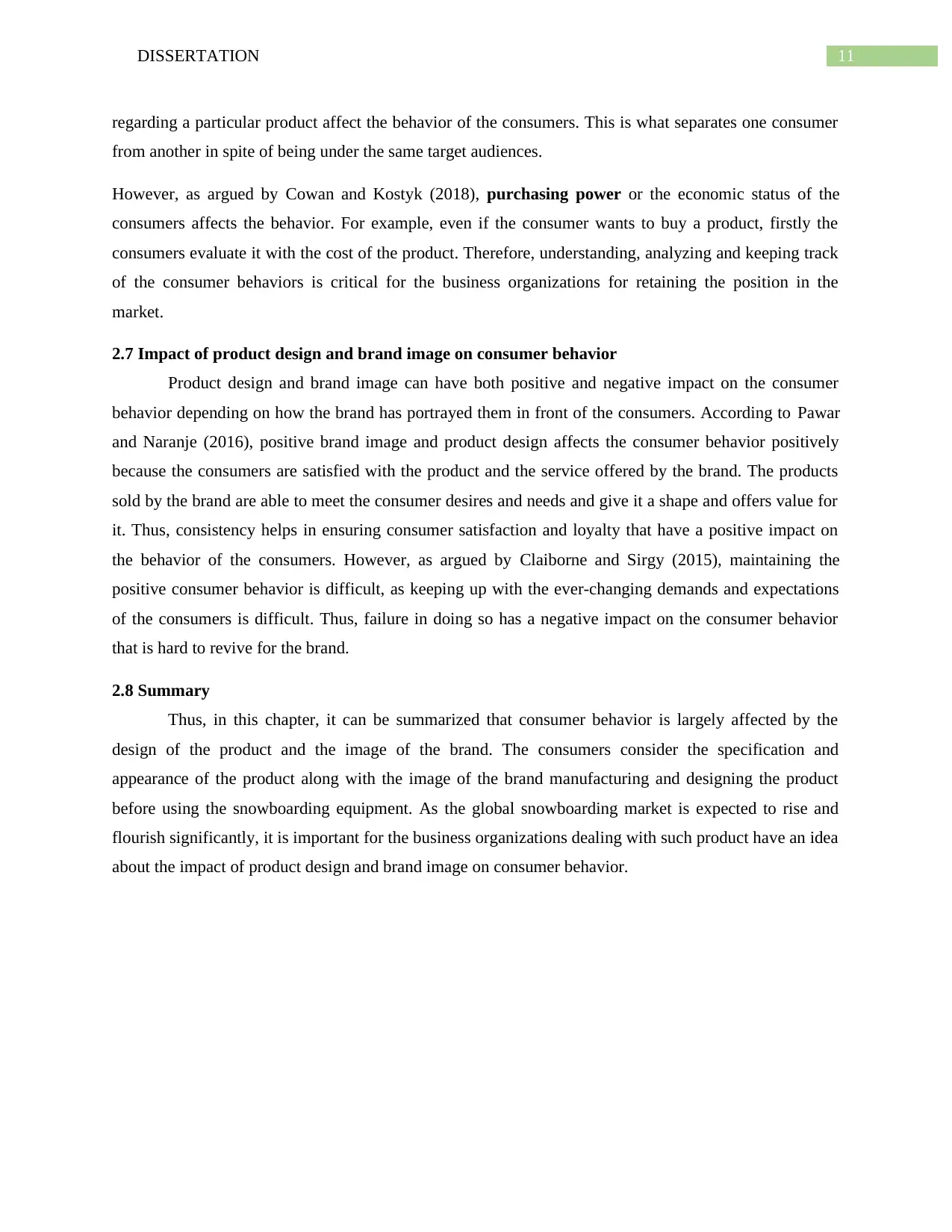
11DISSERTATION
regarding a particular product affect the behavior of the consumers. This is what separates one consumer
from another in spite of being under the same target audiences.
However, as argued by Cowan and Kostyk (2018), purchasing power or the economic status of the
consumers affects the behavior. For example, even if the consumer wants to buy a product, firstly the
consumers evaluate it with the cost of the product. Therefore, understanding, analyzing and keeping track
of the consumer behaviors is critical for the business organizations for retaining the position in the
market.
2.7 Impact of product design and brand image on consumer behavior
Product design and brand image can have both positive and negative impact on the consumer
behavior depending on how the brand has portrayed them in front of the consumers. According to Pawar
and Naranje (2016), positive brand image and product design affects the consumer behavior positively
because the consumers are satisfied with the product and the service offered by the brand. The products
sold by the brand are able to meet the consumer desires and needs and give it a shape and offers value for
it. Thus, consistency helps in ensuring consumer satisfaction and loyalty that have a positive impact on
the behavior of the consumers. However, as argued by Claiborne and Sirgy (2015), maintaining the
positive consumer behavior is difficult, as keeping up with the ever-changing demands and expectations
of the consumers is difficult. Thus, failure in doing so has a negative impact on the consumer behavior
that is hard to revive for the brand.
2.8 Summary
Thus, in this chapter, it can be summarized that consumer behavior is largely affected by the
design of the product and the image of the brand. The consumers consider the specification and
appearance of the product along with the image of the brand manufacturing and designing the product
before using the snowboarding equipment. As the global snowboarding market is expected to rise and
flourish significantly, it is important for the business organizations dealing with such product have an idea
about the impact of product design and brand image on consumer behavior.
regarding a particular product affect the behavior of the consumers. This is what separates one consumer
from another in spite of being under the same target audiences.
However, as argued by Cowan and Kostyk (2018), purchasing power or the economic status of the
consumers affects the behavior. For example, even if the consumer wants to buy a product, firstly the
consumers evaluate it with the cost of the product. Therefore, understanding, analyzing and keeping track
of the consumer behaviors is critical for the business organizations for retaining the position in the
market.
2.7 Impact of product design and brand image on consumer behavior
Product design and brand image can have both positive and negative impact on the consumer
behavior depending on how the brand has portrayed them in front of the consumers. According to Pawar
and Naranje (2016), positive brand image and product design affects the consumer behavior positively
because the consumers are satisfied with the product and the service offered by the brand. The products
sold by the brand are able to meet the consumer desires and needs and give it a shape and offers value for
it. Thus, consistency helps in ensuring consumer satisfaction and loyalty that have a positive impact on
the behavior of the consumers. However, as argued by Claiborne and Sirgy (2015), maintaining the
positive consumer behavior is difficult, as keeping up with the ever-changing demands and expectations
of the consumers is difficult. Thus, failure in doing so has a negative impact on the consumer behavior
that is hard to revive for the brand.
2.8 Summary
Thus, in this chapter, it can be summarized that consumer behavior is largely affected by the
design of the product and the image of the brand. The consumers consider the specification and
appearance of the product along with the image of the brand manufacturing and designing the product
before using the snowboarding equipment. As the global snowboarding market is expected to rise and
flourish significantly, it is important for the business organizations dealing with such product have an idea
about the impact of product design and brand image on consumer behavior.
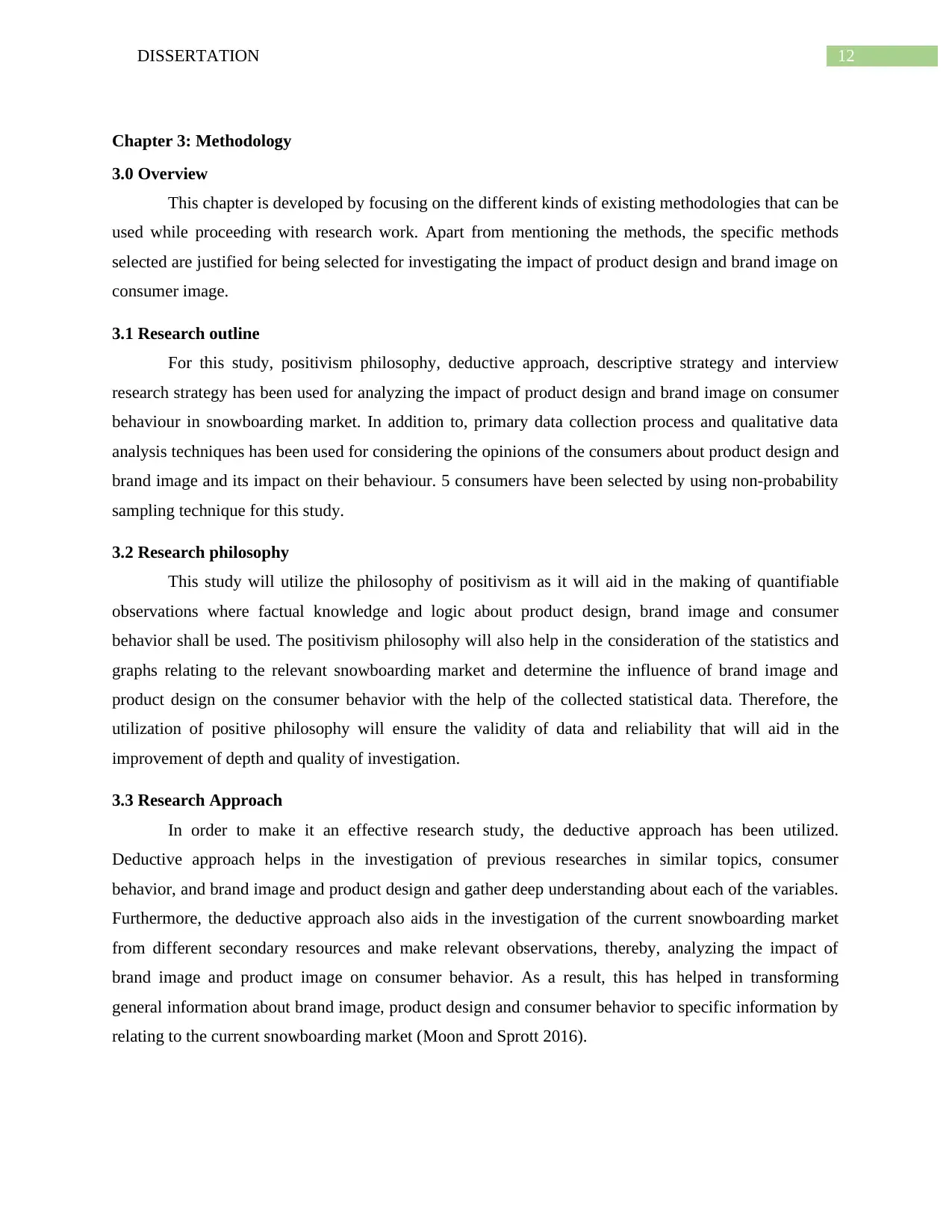
12DISSERTATION
Chapter 3: Methodology
3.0 Overview
This chapter is developed by focusing on the different kinds of existing methodologies that can be
used while proceeding with research work. Apart from mentioning the methods, the specific methods
selected are justified for being selected for investigating the impact of product design and brand image on
consumer image.
3.1 Research outline
For this study, positivism philosophy, deductive approach, descriptive strategy and interview
research strategy has been used for analyzing the impact of product design and brand image on consumer
behaviour in snowboarding market. In addition to, primary data collection process and qualitative data
analysis techniques has been used for considering the opinions of the consumers about product design and
brand image and its impact on their behaviour. 5 consumers have been selected by using non-probability
sampling technique for this study.
3.2 Research philosophy
This study will utilize the philosophy of positivism as it will aid in the making of quantifiable
observations where factual knowledge and logic about product design, brand image and consumer
behavior shall be used. The positivism philosophy will also help in the consideration of the statistics and
graphs relating to the relevant snowboarding market and determine the influence of brand image and
product design on the consumer behavior with the help of the collected statistical data. Therefore, the
utilization of positive philosophy will ensure the validity of data and reliability that will aid in the
improvement of depth and quality of investigation.
3.3 Research Approach
In order to make it an effective research study, the deductive approach has been utilized.
Deductive approach helps in the investigation of previous researches in similar topics, consumer
behavior, and brand image and product design and gather deep understanding about each of the variables.
Furthermore, the deductive approach also aids in the investigation of the current snowboarding market
from different secondary resources and make relevant observations, thereby, analyzing the impact of
brand image and product image on consumer behavior. As a result, this has helped in transforming
general information about brand image, product design and consumer behavior to specific information by
relating to the current snowboarding market (Moon and Sprott 2016).
Chapter 3: Methodology
3.0 Overview
This chapter is developed by focusing on the different kinds of existing methodologies that can be
used while proceeding with research work. Apart from mentioning the methods, the specific methods
selected are justified for being selected for investigating the impact of product design and brand image on
consumer image.
3.1 Research outline
For this study, positivism philosophy, deductive approach, descriptive strategy and interview
research strategy has been used for analyzing the impact of product design and brand image on consumer
behaviour in snowboarding market. In addition to, primary data collection process and qualitative data
analysis techniques has been used for considering the opinions of the consumers about product design and
brand image and its impact on their behaviour. 5 consumers have been selected by using non-probability
sampling technique for this study.
3.2 Research philosophy
This study will utilize the philosophy of positivism as it will aid in the making of quantifiable
observations where factual knowledge and logic about product design, brand image and consumer
behavior shall be used. The positivism philosophy will also help in the consideration of the statistics and
graphs relating to the relevant snowboarding market and determine the influence of brand image and
product design on the consumer behavior with the help of the collected statistical data. Therefore, the
utilization of positive philosophy will ensure the validity of data and reliability that will aid in the
improvement of depth and quality of investigation.
3.3 Research Approach
In order to make it an effective research study, the deductive approach has been utilized.
Deductive approach helps in the investigation of previous researches in similar topics, consumer
behavior, and brand image and product design and gather deep understanding about each of the variables.
Furthermore, the deductive approach also aids in the investigation of the current snowboarding market
from different secondary resources and make relevant observations, thereby, analyzing the impact of
brand image and product image on consumer behavior. As a result, this has helped in transforming
general information about brand image, product design and consumer behavior to specific information by
relating to the current snowboarding market (Moon and Sprott 2016).
Paraphrase This Document
Need a fresh take? Get an instant paraphrase of this document with our AI Paraphraser
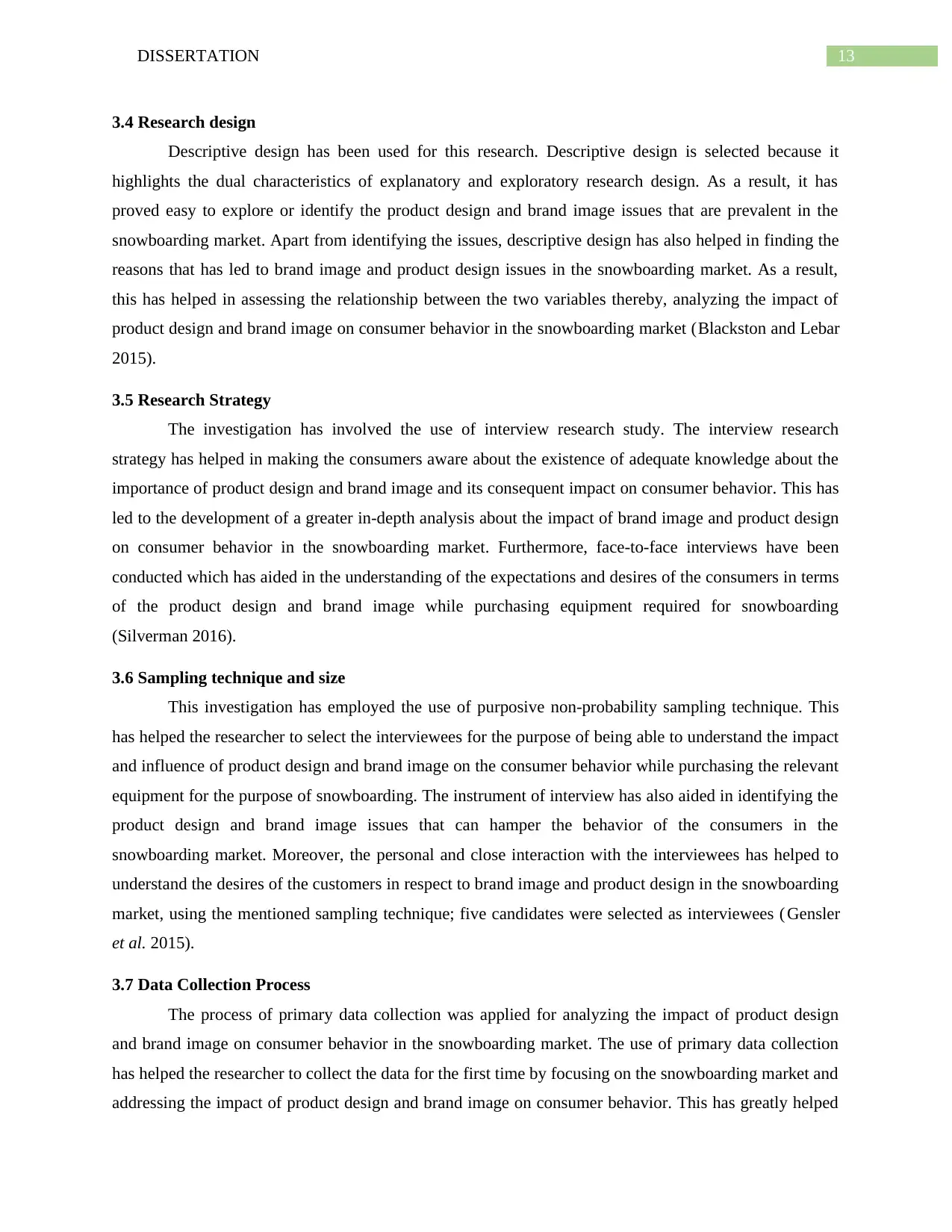
13DISSERTATION
3.4 Research design
Descriptive design has been used for this research. Descriptive design is selected because it
highlights the dual characteristics of explanatory and exploratory research design. As a result, it has
proved easy to explore or identify the product design and brand image issues that are prevalent in the
snowboarding market. Apart from identifying the issues, descriptive design has also helped in finding the
reasons that has led to brand image and product design issues in the snowboarding market. As a result,
this has helped in assessing the relationship between the two variables thereby, analyzing the impact of
product design and brand image on consumer behavior in the snowboarding market (Blackston and Lebar
2015).
3.5 Research Strategy
The investigation has involved the use of interview research study. The interview research
strategy has helped in making the consumers aware about the existence of adequate knowledge about the
importance of product design and brand image and its consequent impact on consumer behavior. This has
led to the development of a greater in-depth analysis about the impact of brand image and product design
on consumer behavior in the snowboarding market. Furthermore, face-to-face interviews have been
conducted which has aided in the understanding of the expectations and desires of the consumers in terms
of the product design and brand image while purchasing equipment required for snowboarding
(Silverman 2016).
3.6 Sampling technique and size
This investigation has employed the use of purposive non-probability sampling technique. This
has helped the researcher to select the interviewees for the purpose of being able to understand the impact
and influence of product design and brand image on the consumer behavior while purchasing the relevant
equipment for the purpose of snowboarding. The instrument of interview has also aided in identifying the
product design and brand image issues that can hamper the behavior of the consumers in the
snowboarding market. Moreover, the personal and close interaction with the interviewees has helped to
understand the desires of the customers in respect to brand image and product design in the snowboarding
market, using the mentioned sampling technique; five candidates were selected as interviewees ( Gensler
et al. 2015).
3.7 Data Collection Process
The process of primary data collection was applied for analyzing the impact of product design
and brand image on consumer behavior in the snowboarding market. The use of primary data collection
has helped the researcher to collect the data for the first time by focusing on the snowboarding market and
addressing the impact of product design and brand image on consumer behavior. This has greatly helped
3.4 Research design
Descriptive design has been used for this research. Descriptive design is selected because it
highlights the dual characteristics of explanatory and exploratory research design. As a result, it has
proved easy to explore or identify the product design and brand image issues that are prevalent in the
snowboarding market. Apart from identifying the issues, descriptive design has also helped in finding the
reasons that has led to brand image and product design issues in the snowboarding market. As a result,
this has helped in assessing the relationship between the two variables thereby, analyzing the impact of
product design and brand image on consumer behavior in the snowboarding market (Blackston and Lebar
2015).
3.5 Research Strategy
The investigation has involved the use of interview research study. The interview research
strategy has helped in making the consumers aware about the existence of adequate knowledge about the
importance of product design and brand image and its consequent impact on consumer behavior. This has
led to the development of a greater in-depth analysis about the impact of brand image and product design
on consumer behavior in the snowboarding market. Furthermore, face-to-face interviews have been
conducted which has aided in the understanding of the expectations and desires of the consumers in terms
of the product design and brand image while purchasing equipment required for snowboarding
(Silverman 2016).
3.6 Sampling technique and size
This investigation has employed the use of purposive non-probability sampling technique. This
has helped the researcher to select the interviewees for the purpose of being able to understand the impact
and influence of product design and brand image on the consumer behavior while purchasing the relevant
equipment for the purpose of snowboarding. The instrument of interview has also aided in identifying the
product design and brand image issues that can hamper the behavior of the consumers in the
snowboarding market. Moreover, the personal and close interaction with the interviewees has helped to
understand the desires of the customers in respect to brand image and product design in the snowboarding
market, using the mentioned sampling technique; five candidates were selected as interviewees ( Gensler
et al. 2015).
3.7 Data Collection Process
The process of primary data collection was applied for analyzing the impact of product design
and brand image on consumer behavior in the snowboarding market. The use of primary data collection
has helped the researcher to collect the data for the first time by focusing on the snowboarding market and
addressing the impact of product design and brand image on consumer behavior. This has greatly helped
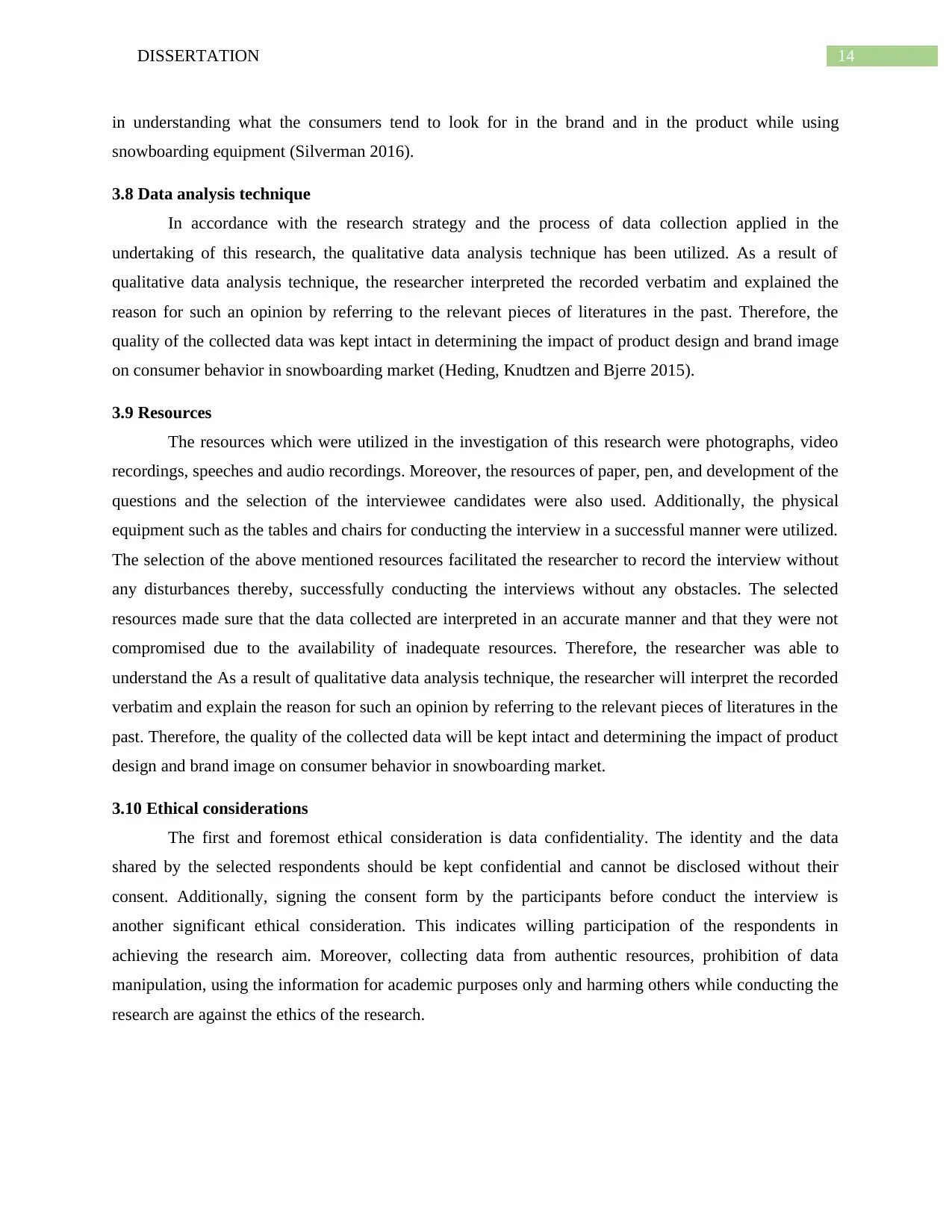
14DISSERTATION
in understanding what the consumers tend to look for in the brand and in the product while using
snowboarding equipment (Silverman 2016).
3.8 Data analysis technique
In accordance with the research strategy and the process of data collection applied in the
undertaking of this research, the qualitative data analysis technique has been utilized. As a result of
qualitative data analysis technique, the researcher interpreted the recorded verbatim and explained the
reason for such an opinion by referring to the relevant pieces of literatures in the past. Therefore, the
quality of the collected data was kept intact in determining the impact of product design and brand image
on consumer behavior in snowboarding market (Heding, Knudtzen and Bjerre 2015).
3.9 Resources
The resources which were utilized in the investigation of this research were photographs, video
recordings, speeches and audio recordings. Moreover, the resources of paper, pen, and development of the
questions and the selection of the interviewee candidates were also used. Additionally, the physical
equipment such as the tables and chairs for conducting the interview in a successful manner were utilized.
The selection of the above mentioned resources facilitated the researcher to record the interview without
any disturbances thereby, successfully conducting the interviews without any obstacles. The selected
resources made sure that the data collected are interpreted in an accurate manner and that they were not
compromised due to the availability of inadequate resources. Therefore, the researcher was able to
understand the As a result of qualitative data analysis technique, the researcher will interpret the recorded
verbatim and explain the reason for such an opinion by referring to the relevant pieces of literatures in the
past. Therefore, the quality of the collected data will be kept intact and determining the impact of product
design and brand image on consumer behavior in snowboarding market.
3.10 Ethical considerations
The first and foremost ethical consideration is data confidentiality. The identity and the data
shared by the selected respondents should be kept confidential and cannot be disclosed without their
consent. Additionally, signing the consent form by the participants before conduct the interview is
another significant ethical consideration. This indicates willing participation of the respondents in
achieving the research aim. Moreover, collecting data from authentic resources, prohibition of data
manipulation, using the information for academic purposes only and harming others while conducting the
research are against the ethics of the research.
in understanding what the consumers tend to look for in the brand and in the product while using
snowboarding equipment (Silverman 2016).
3.8 Data analysis technique
In accordance with the research strategy and the process of data collection applied in the
undertaking of this research, the qualitative data analysis technique has been utilized. As a result of
qualitative data analysis technique, the researcher interpreted the recorded verbatim and explained the
reason for such an opinion by referring to the relevant pieces of literatures in the past. Therefore, the
quality of the collected data was kept intact in determining the impact of product design and brand image
on consumer behavior in snowboarding market (Heding, Knudtzen and Bjerre 2015).
3.9 Resources
The resources which were utilized in the investigation of this research were photographs, video
recordings, speeches and audio recordings. Moreover, the resources of paper, pen, and development of the
questions and the selection of the interviewee candidates were also used. Additionally, the physical
equipment such as the tables and chairs for conducting the interview in a successful manner were utilized.
The selection of the above mentioned resources facilitated the researcher to record the interview without
any disturbances thereby, successfully conducting the interviews without any obstacles. The selected
resources made sure that the data collected are interpreted in an accurate manner and that they were not
compromised due to the availability of inadequate resources. Therefore, the researcher was able to
understand the As a result of qualitative data analysis technique, the researcher will interpret the recorded
verbatim and explain the reason for such an opinion by referring to the relevant pieces of literatures in the
past. Therefore, the quality of the collected data will be kept intact and determining the impact of product
design and brand image on consumer behavior in snowboarding market.
3.10 Ethical considerations
The first and foremost ethical consideration is data confidentiality. The identity and the data
shared by the selected respondents should be kept confidential and cannot be disclosed without their
consent. Additionally, signing the consent form by the participants before conduct the interview is
another significant ethical consideration. This indicates willing participation of the respondents in
achieving the research aim. Moreover, collecting data from authentic resources, prohibition of data
manipulation, using the information for academic purposes only and harming others while conducting the
research are against the ethics of the research.
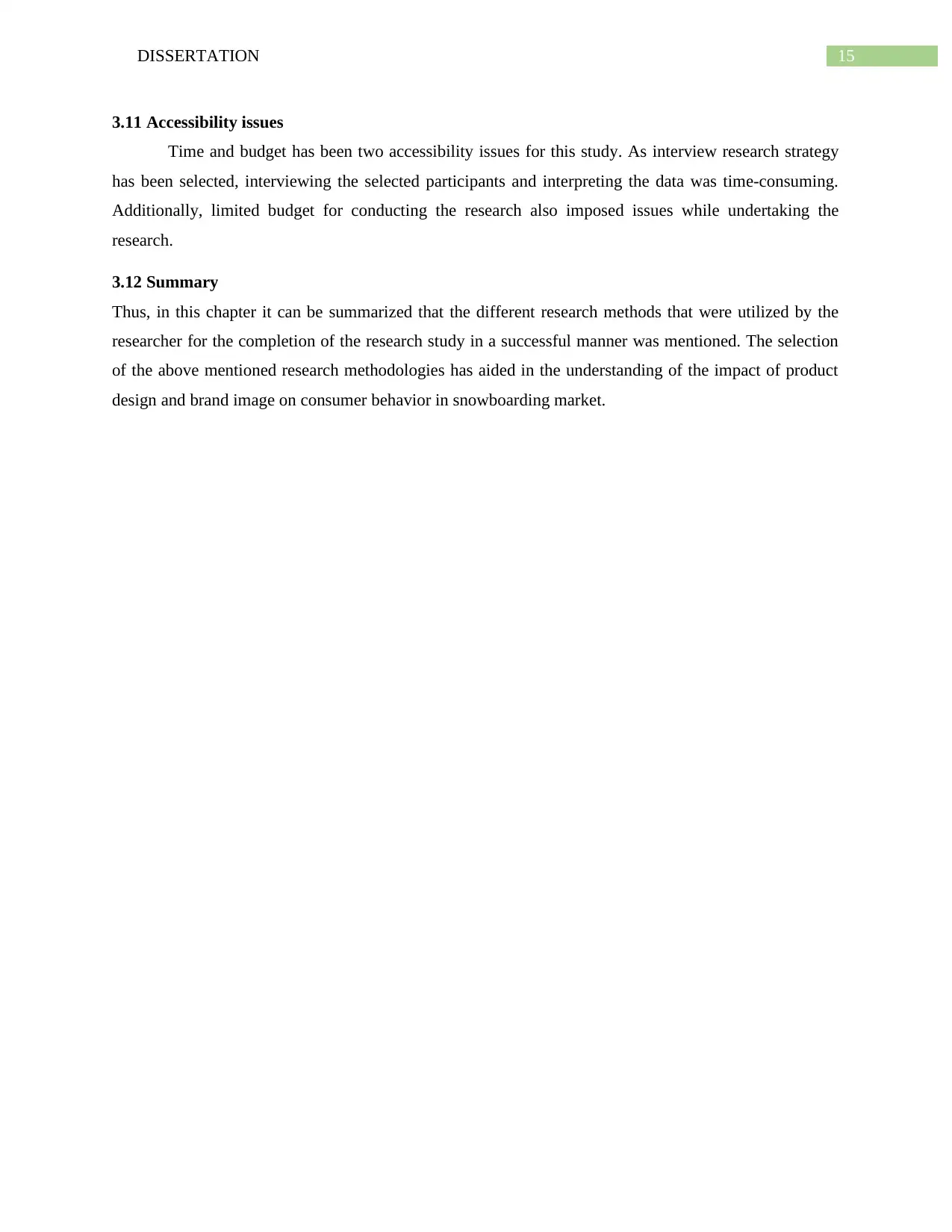
15DISSERTATION
3.11 Accessibility issues
Time and budget has been two accessibility issues for this study. As interview research strategy
has been selected, interviewing the selected participants and interpreting the data was time-consuming.
Additionally, limited budget for conducting the research also imposed issues while undertaking the
research.
3.12 Summary
Thus, in this chapter it can be summarized that the different research methods that were utilized by the
researcher for the completion of the research study in a successful manner was mentioned. The selection
of the above mentioned research methodologies has aided in the understanding of the impact of product
design and brand image on consumer behavior in snowboarding market.
3.11 Accessibility issues
Time and budget has been two accessibility issues for this study. As interview research strategy
has been selected, interviewing the selected participants and interpreting the data was time-consuming.
Additionally, limited budget for conducting the research also imposed issues while undertaking the
research.
3.12 Summary
Thus, in this chapter it can be summarized that the different research methods that were utilized by the
researcher for the completion of the research study in a successful manner was mentioned. The selection
of the above mentioned research methodologies has aided in the understanding of the impact of product
design and brand image on consumer behavior in snowboarding market.
Secure Best Marks with AI Grader
Need help grading? Try our AI Grader for instant feedback on your assignments.
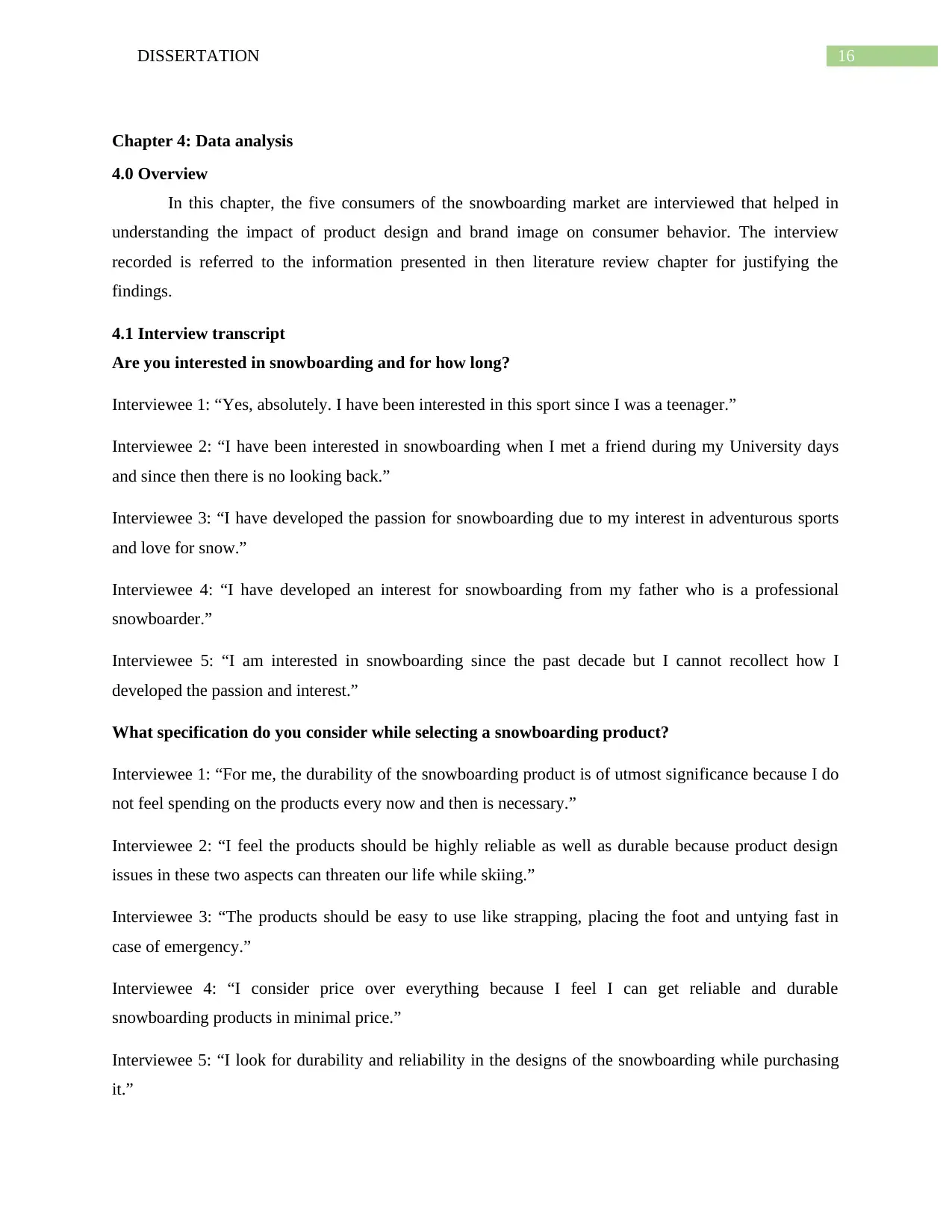
16DISSERTATION
Chapter 4: Data analysis
4.0 Overview
In this chapter, the five consumers of the snowboarding market are interviewed that helped in
understanding the impact of product design and brand image on consumer behavior. The interview
recorded is referred to the information presented in then literature review chapter for justifying the
findings.
4.1 Interview transcript
Are you interested in snowboarding and for how long?
Interviewee 1: “Yes, absolutely. I have been interested in this sport since I was a teenager.”
Interviewee 2: “I have been interested in snowboarding when I met a friend during my University days
and since then there is no looking back.”
Interviewee 3: “I have developed the passion for snowboarding due to my interest in adventurous sports
and love for snow.”
Interviewee 4: “I have developed an interest for snowboarding from my father who is a professional
snowboarder.”
Interviewee 5: “I am interested in snowboarding since the past decade but I cannot recollect how I
developed the passion and interest.”
What specification do you consider while selecting a snowboarding product?
Interviewee 1: “For me, the durability of the snowboarding product is of utmost significance because I do
not feel spending on the products every now and then is necessary.”
Interviewee 2: “I feel the products should be highly reliable as well as durable because product design
issues in these two aspects can threaten our life while skiing.”
Interviewee 3: “The products should be easy to use like strapping, placing the foot and untying fast in
case of emergency.”
Interviewee 4: “I consider price over everything because I feel I can get reliable and durable
snowboarding products in minimal price.”
Interviewee 5: “I look for durability and reliability in the designs of the snowboarding while purchasing
it.”
Chapter 4: Data analysis
4.0 Overview
In this chapter, the five consumers of the snowboarding market are interviewed that helped in
understanding the impact of product design and brand image on consumer behavior. The interview
recorded is referred to the information presented in then literature review chapter for justifying the
findings.
4.1 Interview transcript
Are you interested in snowboarding and for how long?
Interviewee 1: “Yes, absolutely. I have been interested in this sport since I was a teenager.”
Interviewee 2: “I have been interested in snowboarding when I met a friend during my University days
and since then there is no looking back.”
Interviewee 3: “I have developed the passion for snowboarding due to my interest in adventurous sports
and love for snow.”
Interviewee 4: “I have developed an interest for snowboarding from my father who is a professional
snowboarder.”
Interviewee 5: “I am interested in snowboarding since the past decade but I cannot recollect how I
developed the passion and interest.”
What specification do you consider while selecting a snowboarding product?
Interviewee 1: “For me, the durability of the snowboarding product is of utmost significance because I do
not feel spending on the products every now and then is necessary.”
Interviewee 2: “I feel the products should be highly reliable as well as durable because product design
issues in these two aspects can threaten our life while skiing.”
Interviewee 3: “The products should be easy to use like strapping, placing the foot and untying fast in
case of emergency.”
Interviewee 4: “I consider price over everything because I feel I can get reliable and durable
snowboarding products in minimal price.”
Interviewee 5: “I look for durability and reliability in the designs of the snowboarding while purchasing
it.”
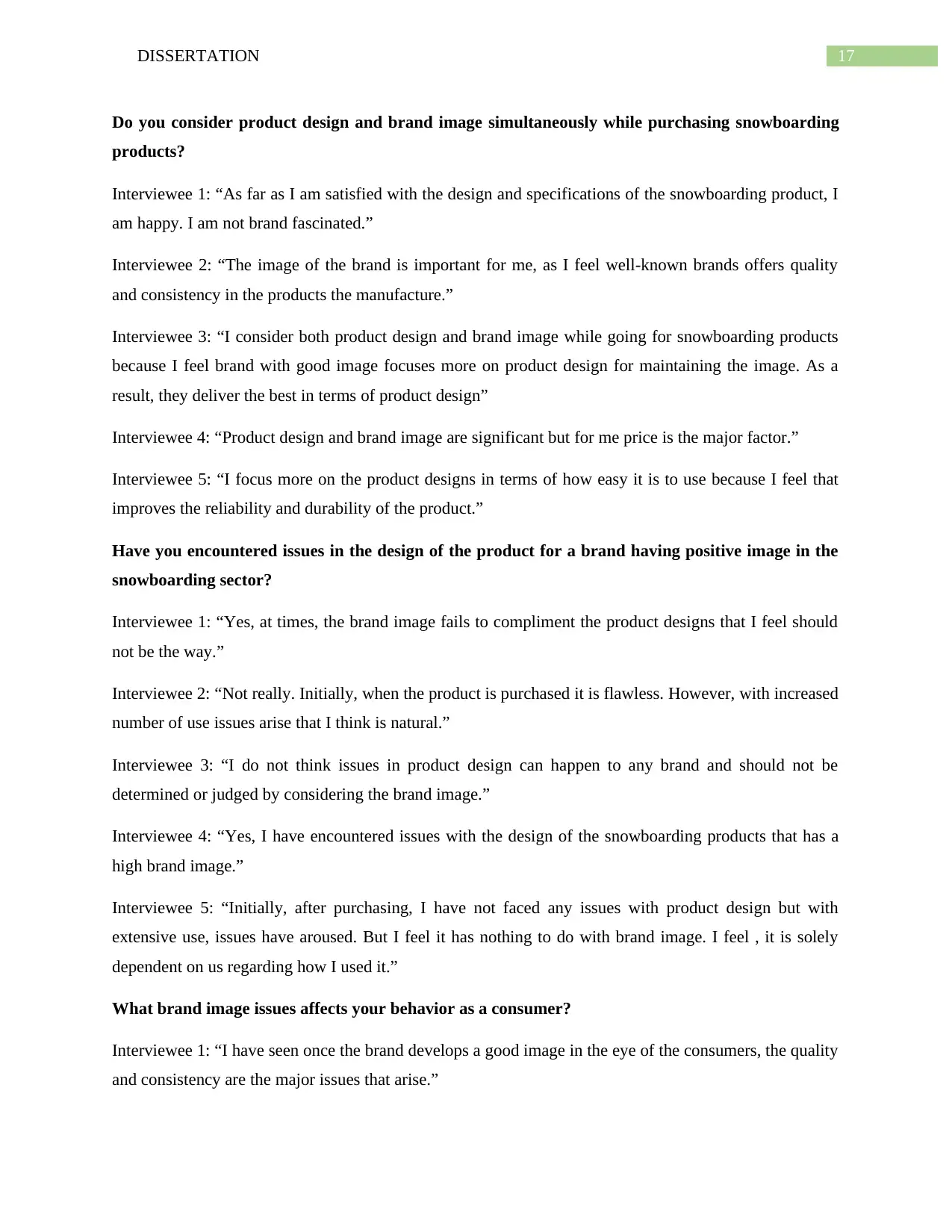
17DISSERTATION
Do you consider product design and brand image simultaneously while purchasing snowboarding
products?
Interviewee 1: “As far as I am satisfied with the design and specifications of the snowboarding product, I
am happy. I am not brand fascinated.”
Interviewee 2: “The image of the brand is important for me, as I feel well-known brands offers quality
and consistency in the products the manufacture.”
Interviewee 3: “I consider both product design and brand image while going for snowboarding products
because I feel brand with good image focuses more on product design for maintaining the image. As a
result, they deliver the best in terms of product design”
Interviewee 4: “Product design and brand image are significant but for me price is the major factor.”
Interviewee 5: “I focus more on the product designs in terms of how easy it is to use because I feel that
improves the reliability and durability of the product.”
Have you encountered issues in the design of the product for a brand having positive image in the
snowboarding sector?
Interviewee 1: “Yes, at times, the brand image fails to compliment the product designs that I feel should
not be the way.”
Interviewee 2: “Not really. Initially, when the product is purchased it is flawless. However, with increased
number of use issues arise that I think is natural.”
Interviewee 3: “I do not think issues in product design can happen to any brand and should not be
determined or judged by considering the brand image.”
Interviewee 4: “Yes, I have encountered issues with the design of the snowboarding products that has a
high brand image.”
Interviewee 5: “Initially, after purchasing, I have not faced any issues with product design but with
extensive use, issues have aroused. But I feel it has nothing to do with brand image. I feel , it is solely
dependent on us regarding how I used it.”
What brand image issues affects your behavior as a consumer?
Interviewee 1: “I have seen once the brand develops a good image in the eye of the consumers, the quality
and consistency are the major issues that arise.”
Do you consider product design and brand image simultaneously while purchasing snowboarding
products?
Interviewee 1: “As far as I am satisfied with the design and specifications of the snowboarding product, I
am happy. I am not brand fascinated.”
Interviewee 2: “The image of the brand is important for me, as I feel well-known brands offers quality
and consistency in the products the manufacture.”
Interviewee 3: “I consider both product design and brand image while going for snowboarding products
because I feel brand with good image focuses more on product design for maintaining the image. As a
result, they deliver the best in terms of product design”
Interviewee 4: “Product design and brand image are significant but for me price is the major factor.”
Interviewee 5: “I focus more on the product designs in terms of how easy it is to use because I feel that
improves the reliability and durability of the product.”
Have you encountered issues in the design of the product for a brand having positive image in the
snowboarding sector?
Interviewee 1: “Yes, at times, the brand image fails to compliment the product designs that I feel should
not be the way.”
Interviewee 2: “Not really. Initially, when the product is purchased it is flawless. However, with increased
number of use issues arise that I think is natural.”
Interviewee 3: “I do not think issues in product design can happen to any brand and should not be
determined or judged by considering the brand image.”
Interviewee 4: “Yes, I have encountered issues with the design of the snowboarding products that has a
high brand image.”
Interviewee 5: “Initially, after purchasing, I have not faced any issues with product design but with
extensive use, issues have aroused. But I feel it has nothing to do with brand image. I feel , it is solely
dependent on us regarding how I used it.”
What brand image issues affects your behavior as a consumer?
Interviewee 1: “I have seen once the brand develops a good image in the eye of the consumers, the quality
and consistency are the major issues that arise.”
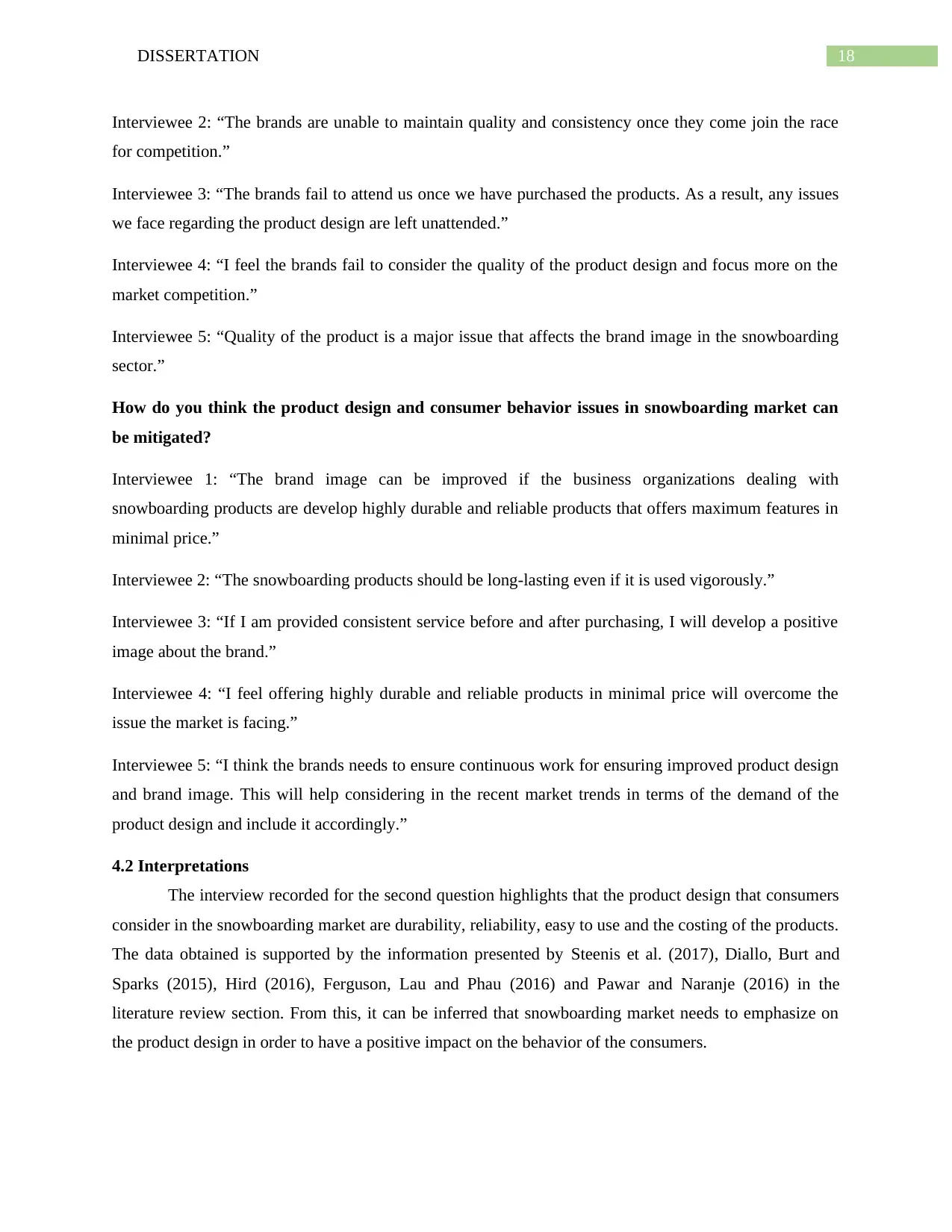
18DISSERTATION
Interviewee 2: “The brands are unable to maintain quality and consistency once they come join the race
for competition.”
Interviewee 3: “The brands fail to attend us once we have purchased the products. As a result, any issues
we face regarding the product design are left unattended.”
Interviewee 4: “I feel the brands fail to consider the quality of the product design and focus more on the
market competition.”
Interviewee 5: “Quality of the product is a major issue that affects the brand image in the snowboarding
sector.”
How do you think the product design and consumer behavior issues in snowboarding market can
be mitigated?
Interviewee 1: “The brand image can be improved if the business organizations dealing with
snowboarding products are develop highly durable and reliable products that offers maximum features in
minimal price.”
Interviewee 2: “The snowboarding products should be long-lasting even if it is used vigorously.”
Interviewee 3: “If I am provided consistent service before and after purchasing, I will develop a positive
image about the brand.”
Interviewee 4: “I feel offering highly durable and reliable products in minimal price will overcome the
issue the market is facing.”
Interviewee 5: “I think the brands needs to ensure continuous work for ensuring improved product design
and brand image. This will help considering in the recent market trends in terms of the demand of the
product design and include it accordingly.”
4.2 Interpretations
The interview recorded for the second question highlights that the product design that consumers
consider in the snowboarding market are durability, reliability, easy to use and the costing of the products.
The data obtained is supported by the information presented by Steenis et al. (2017), Diallo, Burt and
Sparks (2015), Hird (2016), Ferguson, Lau and Phau (2016) and Pawar and Naranje (2016) in the
literature review section. From this, it can be inferred that snowboarding market needs to emphasize on
the product design in order to have a positive impact on the behavior of the consumers.
Interviewee 2: “The brands are unable to maintain quality and consistency once they come join the race
for competition.”
Interviewee 3: “The brands fail to attend us once we have purchased the products. As a result, any issues
we face regarding the product design are left unattended.”
Interviewee 4: “I feel the brands fail to consider the quality of the product design and focus more on the
market competition.”
Interviewee 5: “Quality of the product is a major issue that affects the brand image in the snowboarding
sector.”
How do you think the product design and consumer behavior issues in snowboarding market can
be mitigated?
Interviewee 1: “The brand image can be improved if the business organizations dealing with
snowboarding products are develop highly durable and reliable products that offers maximum features in
minimal price.”
Interviewee 2: “The snowboarding products should be long-lasting even if it is used vigorously.”
Interviewee 3: “If I am provided consistent service before and after purchasing, I will develop a positive
image about the brand.”
Interviewee 4: “I feel offering highly durable and reliable products in minimal price will overcome the
issue the market is facing.”
Interviewee 5: “I think the brands needs to ensure continuous work for ensuring improved product design
and brand image. This will help considering in the recent market trends in terms of the demand of the
product design and include it accordingly.”
4.2 Interpretations
The interview recorded for the second question highlights that the product design that consumers
consider in the snowboarding market are durability, reliability, easy to use and the costing of the products.
The data obtained is supported by the information presented by Steenis et al. (2017), Diallo, Burt and
Sparks (2015), Hird (2016), Ferguson, Lau and Phau (2016) and Pawar and Naranje (2016) in the
literature review section. From this, it can be inferred that snowboarding market needs to emphasize on
the product design in order to have a positive impact on the behavior of the consumers.
Paraphrase This Document
Need a fresh take? Get an instant paraphrase of this document with our AI Paraphraser
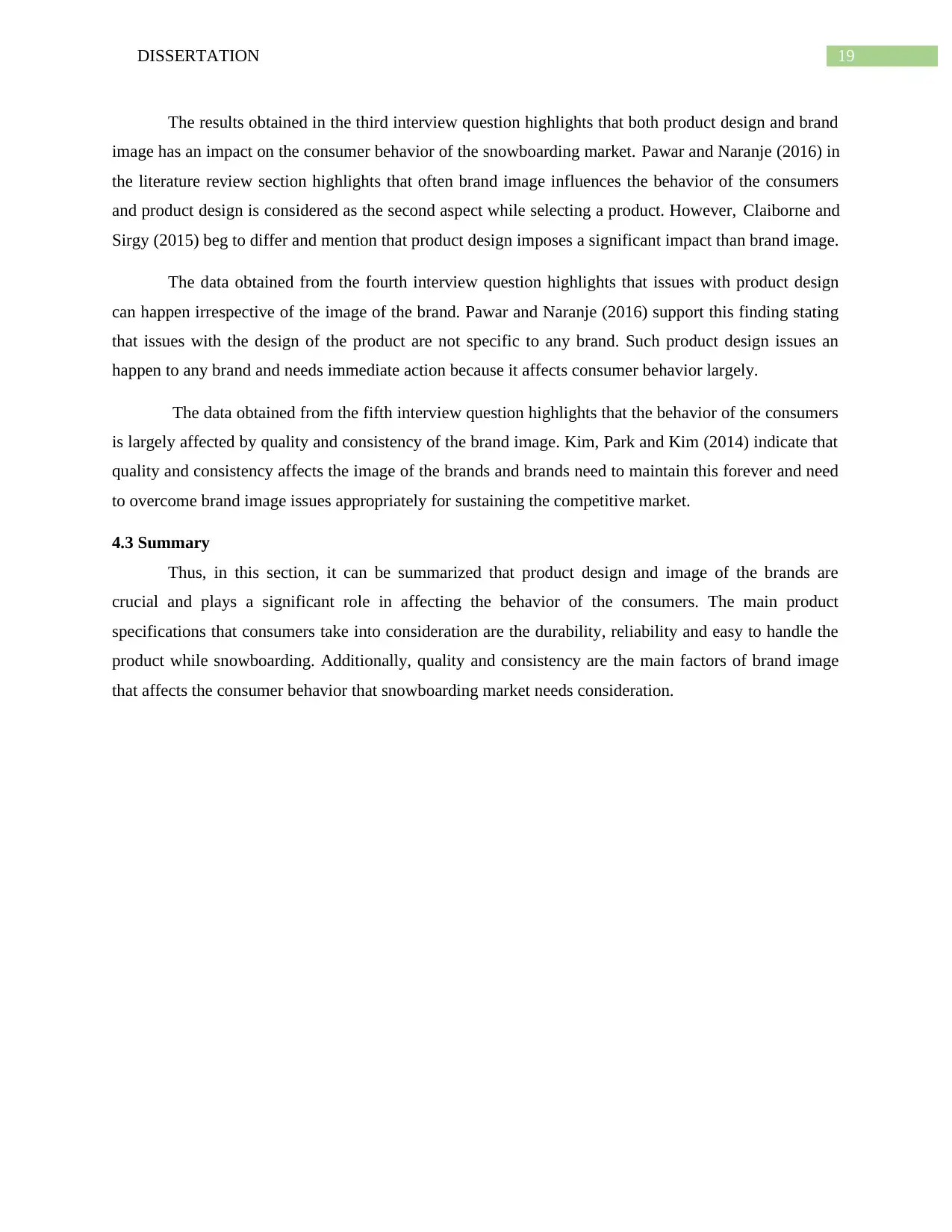
19DISSERTATION
The results obtained in the third interview question highlights that both product design and brand
image has an impact on the consumer behavior of the snowboarding market. Pawar and Naranje (2016) in
the literature review section highlights that often brand image influences the behavior of the consumers
and product design is considered as the second aspect while selecting a product. However, Claiborne and
Sirgy (2015) beg to differ and mention that product design imposes a significant impact than brand image.
The data obtained from the fourth interview question highlights that issues with product design
can happen irrespective of the image of the brand. Pawar and Naranje (2016) support this finding stating
that issues with the design of the product are not specific to any brand. Such product design issues an
happen to any brand and needs immediate action because it affects consumer behavior largely.
The data obtained from the fifth interview question highlights that the behavior of the consumers
is largely affected by quality and consistency of the brand image. Kim, Park and Kim (2014) indicate that
quality and consistency affects the image of the brands and brands need to maintain this forever and need
to overcome brand image issues appropriately for sustaining the competitive market.
4.3 Summary
Thus, in this section, it can be summarized that product design and image of the brands are
crucial and plays a significant role in affecting the behavior of the consumers. The main product
specifications that consumers take into consideration are the durability, reliability and easy to handle the
product while snowboarding. Additionally, quality and consistency are the main factors of brand image
that affects the consumer behavior that snowboarding market needs consideration.
The results obtained in the third interview question highlights that both product design and brand
image has an impact on the consumer behavior of the snowboarding market. Pawar and Naranje (2016) in
the literature review section highlights that often brand image influences the behavior of the consumers
and product design is considered as the second aspect while selecting a product. However, Claiborne and
Sirgy (2015) beg to differ and mention that product design imposes a significant impact than brand image.
The data obtained from the fourth interview question highlights that issues with product design
can happen irrespective of the image of the brand. Pawar and Naranje (2016) support this finding stating
that issues with the design of the product are not specific to any brand. Such product design issues an
happen to any brand and needs immediate action because it affects consumer behavior largely.
The data obtained from the fifth interview question highlights that the behavior of the consumers
is largely affected by quality and consistency of the brand image. Kim, Park and Kim (2014) indicate that
quality and consistency affects the image of the brands and brands need to maintain this forever and need
to overcome brand image issues appropriately for sustaining the competitive market.
4.3 Summary
Thus, in this section, it can be summarized that product design and image of the brands are
crucial and plays a significant role in affecting the behavior of the consumers. The main product
specifications that consumers take into consideration are the durability, reliability and easy to handle the
product while snowboarding. Additionally, quality and consistency are the main factors of brand image
that affects the consumer behavior that snowboarding market needs consideration.
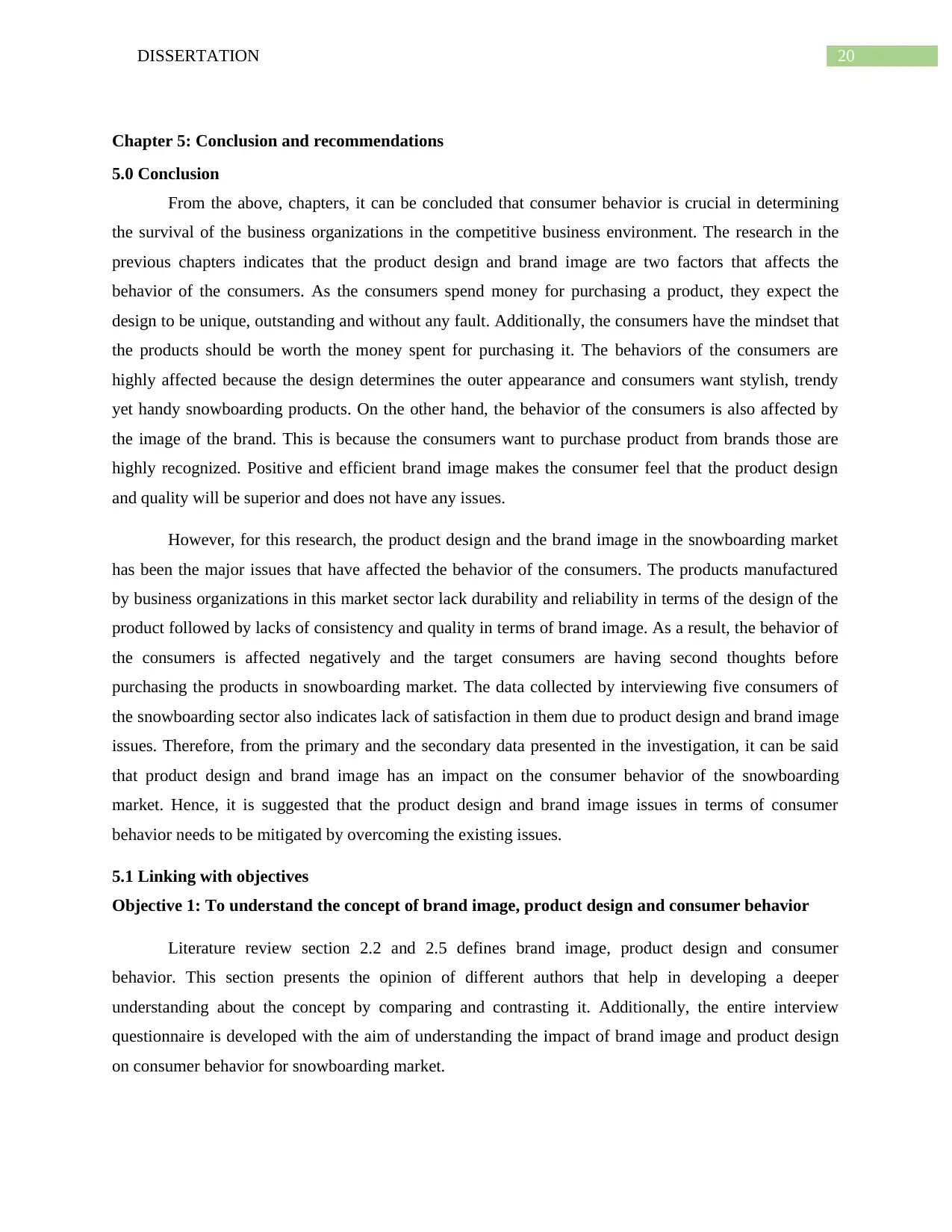
20DISSERTATION
Chapter 5: Conclusion and recommendations
5.0 Conclusion
From the above, chapters, it can be concluded that consumer behavior is crucial in determining
the survival of the business organizations in the competitive business environment. The research in the
previous chapters indicates that the product design and brand image are two factors that affects the
behavior of the consumers. As the consumers spend money for purchasing a product, they expect the
design to be unique, outstanding and without any fault. Additionally, the consumers have the mindset that
the products should be worth the money spent for purchasing it. The behaviors of the consumers are
highly affected because the design determines the outer appearance and consumers want stylish, trendy
yet handy snowboarding products. On the other hand, the behavior of the consumers is also affected by
the image of the brand. This is because the consumers want to purchase product from brands those are
highly recognized. Positive and efficient brand image makes the consumer feel that the product design
and quality will be superior and does not have any issues.
However, for this research, the product design and the brand image in the snowboarding market
has been the major issues that have affected the behavior of the consumers. The products manufactured
by business organizations in this market sector lack durability and reliability in terms of the design of the
product followed by lacks of consistency and quality in terms of brand image. As a result, the behavior of
the consumers is affected negatively and the target consumers are having second thoughts before
purchasing the products in snowboarding market. The data collected by interviewing five consumers of
the snowboarding sector also indicates lack of satisfaction in them due to product design and brand image
issues. Therefore, from the primary and the secondary data presented in the investigation, it can be said
that product design and brand image has an impact on the consumer behavior of the snowboarding
market. Hence, it is suggested that the product design and brand image issues in terms of consumer
behavior needs to be mitigated by overcoming the existing issues.
5.1 Linking with objectives
Objective 1: To understand the concept of brand image, product design and consumer behavior
Literature review section 2.2 and 2.5 defines brand image, product design and consumer
behavior. This section presents the opinion of different authors that help in developing a deeper
understanding about the concept by comparing and contrasting it. Additionally, the entire interview
questionnaire is developed with the aim of understanding the impact of brand image and product design
on consumer behavior for snowboarding market.
Chapter 5: Conclusion and recommendations
5.0 Conclusion
From the above, chapters, it can be concluded that consumer behavior is crucial in determining
the survival of the business organizations in the competitive business environment. The research in the
previous chapters indicates that the product design and brand image are two factors that affects the
behavior of the consumers. As the consumers spend money for purchasing a product, they expect the
design to be unique, outstanding and without any fault. Additionally, the consumers have the mindset that
the products should be worth the money spent for purchasing it. The behaviors of the consumers are
highly affected because the design determines the outer appearance and consumers want stylish, trendy
yet handy snowboarding products. On the other hand, the behavior of the consumers is also affected by
the image of the brand. This is because the consumers want to purchase product from brands those are
highly recognized. Positive and efficient brand image makes the consumer feel that the product design
and quality will be superior and does not have any issues.
However, for this research, the product design and the brand image in the snowboarding market
has been the major issues that have affected the behavior of the consumers. The products manufactured
by business organizations in this market sector lack durability and reliability in terms of the design of the
product followed by lacks of consistency and quality in terms of brand image. As a result, the behavior of
the consumers is affected negatively and the target consumers are having second thoughts before
purchasing the products in snowboarding market. The data collected by interviewing five consumers of
the snowboarding sector also indicates lack of satisfaction in them due to product design and brand image
issues. Therefore, from the primary and the secondary data presented in the investigation, it can be said
that product design and brand image has an impact on the consumer behavior of the snowboarding
market. Hence, it is suggested that the product design and brand image issues in terms of consumer
behavior needs to be mitigated by overcoming the existing issues.
5.1 Linking with objectives
Objective 1: To understand the concept of brand image, product design and consumer behavior
Literature review section 2.2 and 2.5 defines brand image, product design and consumer
behavior. This section presents the opinion of different authors that help in developing a deeper
understanding about the concept by comparing and contrasting it. Additionally, the entire interview
questionnaire is developed with the aim of understanding the impact of brand image and product design
on consumer behavior for snowboarding market.
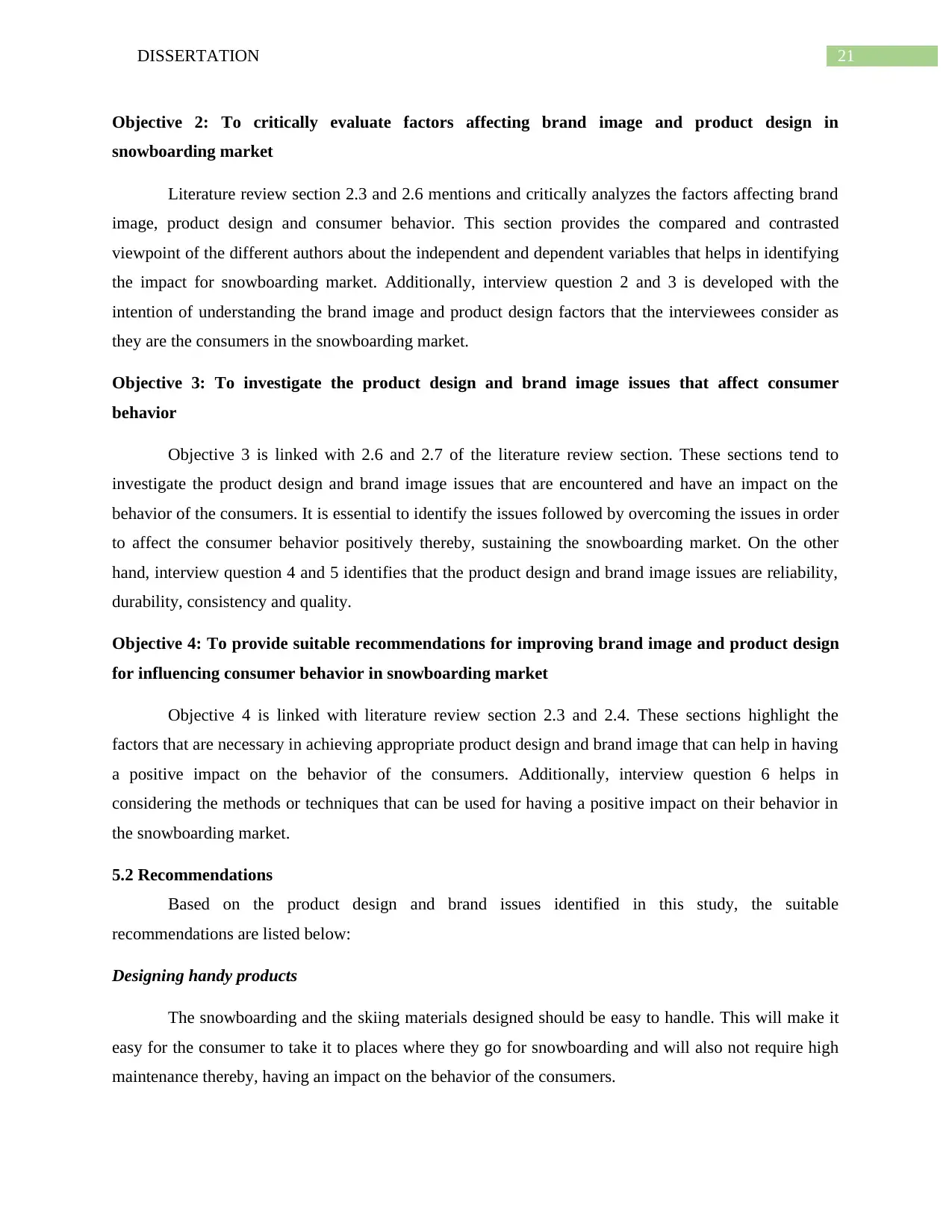
21DISSERTATION
Objective 2: To critically evaluate factors affecting brand image and product design in
snowboarding market
Literature review section 2.3 and 2.6 mentions and critically analyzes the factors affecting brand
image, product design and consumer behavior. This section provides the compared and contrasted
viewpoint of the different authors about the independent and dependent variables that helps in identifying
the impact for snowboarding market. Additionally, interview question 2 and 3 is developed with the
intention of understanding the brand image and product design factors that the interviewees consider as
they are the consumers in the snowboarding market.
Objective 3: To investigate the product design and brand image issues that affect consumer
behavior
Objective 3 is linked with 2.6 and 2.7 of the literature review section. These sections tend to
investigate the product design and brand image issues that are encountered and have an impact on the
behavior of the consumers. It is essential to identify the issues followed by overcoming the issues in order
to affect the consumer behavior positively thereby, sustaining the snowboarding market. On the other
hand, interview question 4 and 5 identifies that the product design and brand image issues are reliability,
durability, consistency and quality.
Objective 4: To provide suitable recommendations for improving brand image and product design
for influencing consumer behavior in snowboarding market
Objective 4 is linked with literature review section 2.3 and 2.4. These sections highlight the
factors that are necessary in achieving appropriate product design and brand image that can help in having
a positive impact on the behavior of the consumers. Additionally, interview question 6 helps in
considering the methods or techniques that can be used for having a positive impact on their behavior in
the snowboarding market.
5.2 Recommendations
Based on the product design and brand issues identified in this study, the suitable
recommendations are listed below:
Designing handy products
The snowboarding and the skiing materials designed should be easy to handle. This will make it
easy for the consumer to take it to places where they go for snowboarding and will also not require high
maintenance thereby, having an impact on the behavior of the consumers.
Objective 2: To critically evaluate factors affecting brand image and product design in
snowboarding market
Literature review section 2.3 and 2.6 mentions and critically analyzes the factors affecting brand
image, product design and consumer behavior. This section provides the compared and contrasted
viewpoint of the different authors about the independent and dependent variables that helps in identifying
the impact for snowboarding market. Additionally, interview question 2 and 3 is developed with the
intention of understanding the brand image and product design factors that the interviewees consider as
they are the consumers in the snowboarding market.
Objective 3: To investigate the product design and brand image issues that affect consumer
behavior
Objective 3 is linked with 2.6 and 2.7 of the literature review section. These sections tend to
investigate the product design and brand image issues that are encountered and have an impact on the
behavior of the consumers. It is essential to identify the issues followed by overcoming the issues in order
to affect the consumer behavior positively thereby, sustaining the snowboarding market. On the other
hand, interview question 4 and 5 identifies that the product design and brand image issues are reliability,
durability, consistency and quality.
Objective 4: To provide suitable recommendations for improving brand image and product design
for influencing consumer behavior in snowboarding market
Objective 4 is linked with literature review section 2.3 and 2.4. These sections highlight the
factors that are necessary in achieving appropriate product design and brand image that can help in having
a positive impact on the behavior of the consumers. Additionally, interview question 6 helps in
considering the methods or techniques that can be used for having a positive impact on their behavior in
the snowboarding market.
5.2 Recommendations
Based on the product design and brand issues identified in this study, the suitable
recommendations are listed below:
Designing handy products
The snowboarding and the skiing materials designed should be easy to handle. This will make it
easy for the consumer to take it to places where they go for snowboarding and will also not require high
maintenance thereby, having an impact on the behavior of the consumers.
Secure Best Marks with AI Grader
Need help grading? Try our AI Grader for instant feedback on your assignments.
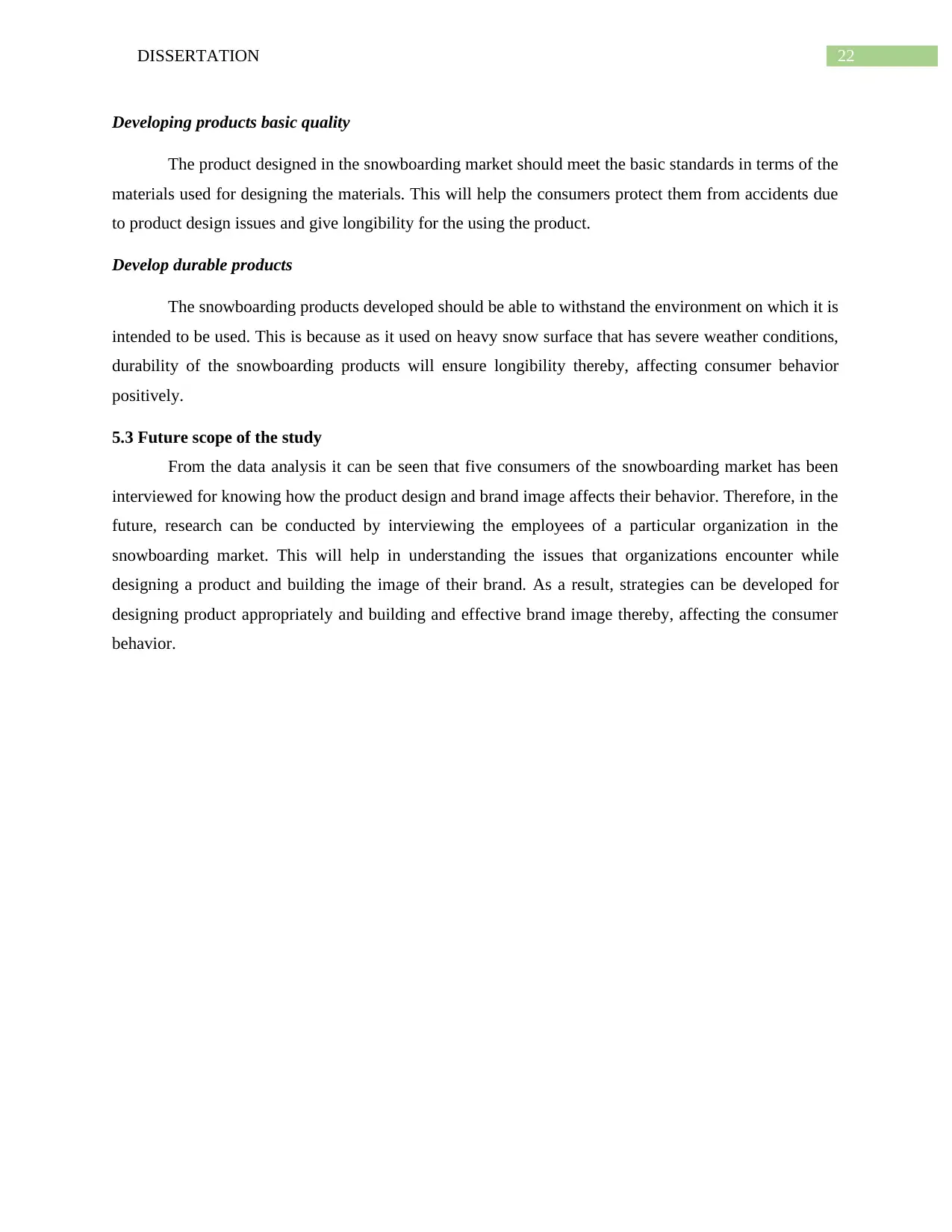
22DISSERTATION
Developing products basic quality
The product designed in the snowboarding market should meet the basic standards in terms of the
materials used for designing the materials. This will help the consumers protect them from accidents due
to product design issues and give longibility for the using the product.
Develop durable products
The snowboarding products developed should be able to withstand the environment on which it is
intended to be used. This is because as it used on heavy snow surface that has severe weather conditions,
durability of the snowboarding products will ensure longibility thereby, affecting consumer behavior
positively.
5.3 Future scope of the study
From the data analysis it can be seen that five consumers of the snowboarding market has been
interviewed for knowing how the product design and brand image affects their behavior. Therefore, in the
future, research can be conducted by interviewing the employees of a particular organization in the
snowboarding market. This will help in understanding the issues that organizations encounter while
designing a product and building the image of their brand. As a result, strategies can be developed for
designing product appropriately and building and effective brand image thereby, affecting the consumer
behavior.
Developing products basic quality
The product designed in the snowboarding market should meet the basic standards in terms of the
materials used for designing the materials. This will help the consumers protect them from accidents due
to product design issues and give longibility for the using the product.
Develop durable products
The snowboarding products developed should be able to withstand the environment on which it is
intended to be used. This is because as it used on heavy snow surface that has severe weather conditions,
durability of the snowboarding products will ensure longibility thereby, affecting consumer behavior
positively.
5.3 Future scope of the study
From the data analysis it can be seen that five consumers of the snowboarding market has been
interviewed for knowing how the product design and brand image affects their behavior. Therefore, in the
future, research can be conducted by interviewing the employees of a particular organization in the
snowboarding market. This will help in understanding the issues that organizations encounter while
designing a product and building the image of their brand. As a result, strategies can be developed for
designing product appropriately and building and effective brand image thereby, affecting the consumer
behavior.
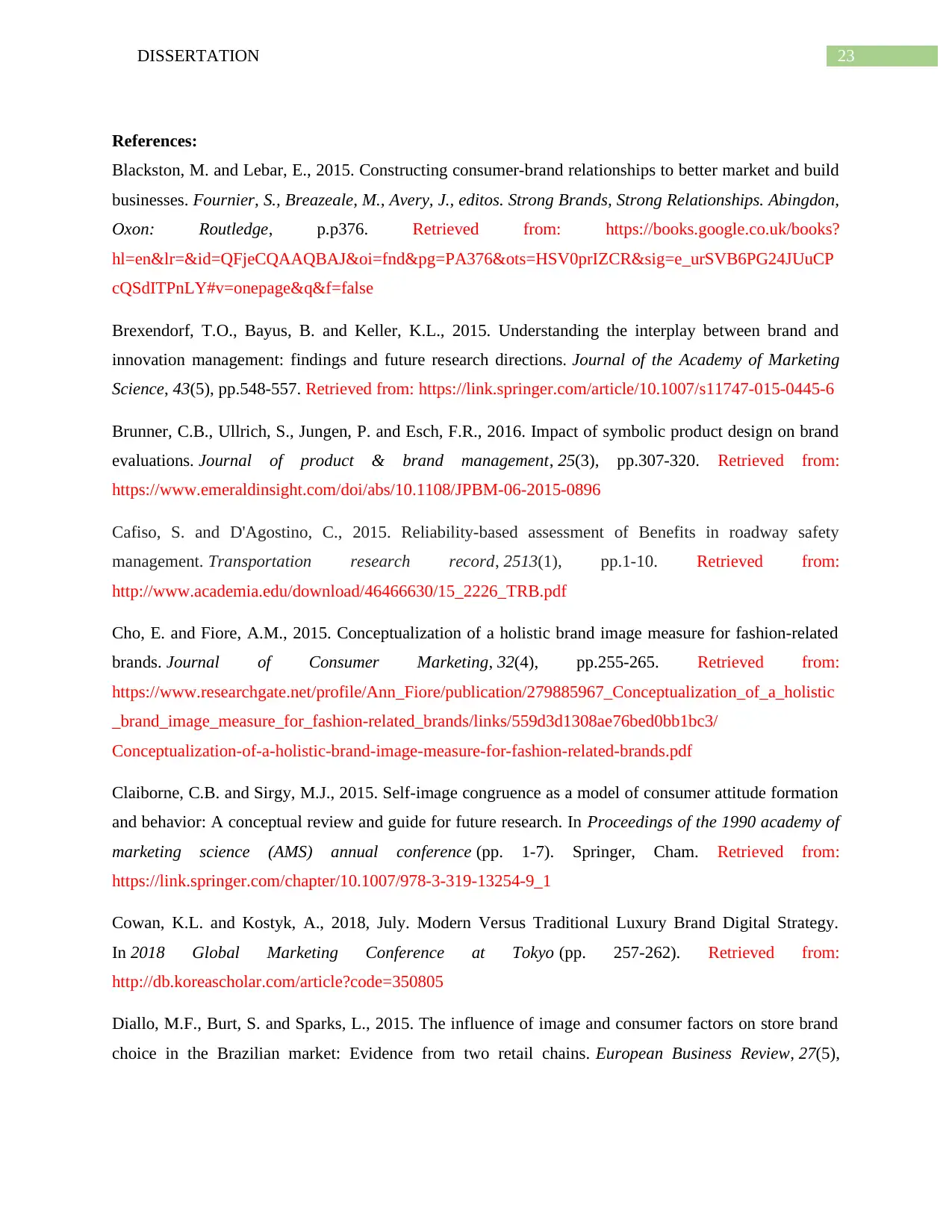
23DISSERTATION
References:
Blackston, M. and Lebar, E., 2015. Constructing consumer-brand relationships to better market and build
businesses. Fournier, S., Breazeale, M., Avery, J., editos. Strong Brands, Strong Relationships. Abingdon,
Oxon: Routledge, p.p376. Retrieved from: https://books.google.co.uk/books?
hl=en&lr=&id=QFjeCQAAQBAJ&oi=fnd&pg=PA376&ots=HSV0prIZCR&sig=e_urSVB6PG24JUuCP
cQSdITPnLY#v=onepage&q&f=false
Brexendorf, T.O., Bayus, B. and Keller, K.L., 2015. Understanding the interplay between brand and
innovation management: findings and future research directions. Journal of the Academy of Marketing
Science, 43(5), pp.548-557. Retrieved from: https://link.springer.com/article/10.1007/s11747-015-0445-6
Brunner, C.B., Ullrich, S., Jungen, P. and Esch, F.R., 2016. Impact of symbolic product design on brand
evaluations. Journal of product & brand management, 25(3), pp.307-320. Retrieved from:
https://www.emeraldinsight.com/doi/abs/10.1108/JPBM-06-2015-0896
Cafiso, S. and D'Agostino, C., 2015. Reliability-based assessment of Benefits in roadway safety
management. Transportation research record, 2513(1), pp.1-10. Retrieved from:
http://www.academia.edu/download/46466630/15_2226_TRB.pdf
Cho, E. and Fiore, A.M., 2015. Conceptualization of a holistic brand image measure for fashion-related
brands. Journal of Consumer Marketing, 32(4), pp.255-265. Retrieved from:
https://www.researchgate.net/profile/Ann_Fiore/publication/279885967_Conceptualization_of_a_holistic
_brand_image_measure_for_fashion-related_brands/links/559d3d1308ae76bed0bb1bc3/
Conceptualization-of-a-holistic-brand-image-measure-for-fashion-related-brands.pdf
Claiborne, C.B. and Sirgy, M.J., 2015. Self-image congruence as a model of consumer attitude formation
and behavior: A conceptual review and guide for future research. In Proceedings of the 1990 academy of
marketing science (AMS) annual conference (pp. 1-7). Springer, Cham. Retrieved from:
https://link.springer.com/chapter/10.1007/978-3-319-13254-9_1
Cowan, K.L. and Kostyk, A., 2018, July. Modern Versus Traditional Luxury Brand Digital Strategy.
In 2018 Global Marketing Conference at Tokyo (pp. 257-262). Retrieved from:
http://db.koreascholar.com/article?code=350805
Diallo, M.F., Burt, S. and Sparks, L., 2015. The influence of image and consumer factors on store brand
choice in the Brazilian market: Evidence from two retail chains. European Business Review, 27(5),
References:
Blackston, M. and Lebar, E., 2015. Constructing consumer-brand relationships to better market and build
businesses. Fournier, S., Breazeale, M., Avery, J., editos. Strong Brands, Strong Relationships. Abingdon,
Oxon: Routledge, p.p376. Retrieved from: https://books.google.co.uk/books?
hl=en&lr=&id=QFjeCQAAQBAJ&oi=fnd&pg=PA376&ots=HSV0prIZCR&sig=e_urSVB6PG24JUuCP
cQSdITPnLY#v=onepage&q&f=false
Brexendorf, T.O., Bayus, B. and Keller, K.L., 2015. Understanding the interplay between brand and
innovation management: findings and future research directions. Journal of the Academy of Marketing
Science, 43(5), pp.548-557. Retrieved from: https://link.springer.com/article/10.1007/s11747-015-0445-6
Brunner, C.B., Ullrich, S., Jungen, P. and Esch, F.R., 2016. Impact of symbolic product design on brand
evaluations. Journal of product & brand management, 25(3), pp.307-320. Retrieved from:
https://www.emeraldinsight.com/doi/abs/10.1108/JPBM-06-2015-0896
Cafiso, S. and D'Agostino, C., 2015. Reliability-based assessment of Benefits in roadway safety
management. Transportation research record, 2513(1), pp.1-10. Retrieved from:
http://www.academia.edu/download/46466630/15_2226_TRB.pdf
Cho, E. and Fiore, A.M., 2015. Conceptualization of a holistic brand image measure for fashion-related
brands. Journal of Consumer Marketing, 32(4), pp.255-265. Retrieved from:
https://www.researchgate.net/profile/Ann_Fiore/publication/279885967_Conceptualization_of_a_holistic
_brand_image_measure_for_fashion-related_brands/links/559d3d1308ae76bed0bb1bc3/
Conceptualization-of-a-holistic-brand-image-measure-for-fashion-related-brands.pdf
Claiborne, C.B. and Sirgy, M.J., 2015. Self-image congruence as a model of consumer attitude formation
and behavior: A conceptual review and guide for future research. In Proceedings of the 1990 academy of
marketing science (AMS) annual conference (pp. 1-7). Springer, Cham. Retrieved from:
https://link.springer.com/chapter/10.1007/978-3-319-13254-9_1
Cowan, K.L. and Kostyk, A., 2018, July. Modern Versus Traditional Luxury Brand Digital Strategy.
In 2018 Global Marketing Conference at Tokyo (pp. 257-262). Retrieved from:
http://db.koreascholar.com/article?code=350805
Diallo, M.F., Burt, S. and Sparks, L., 2015. The influence of image and consumer factors on store brand
choice in the Brazilian market: Evidence from two retail chains. European Business Review, 27(5),
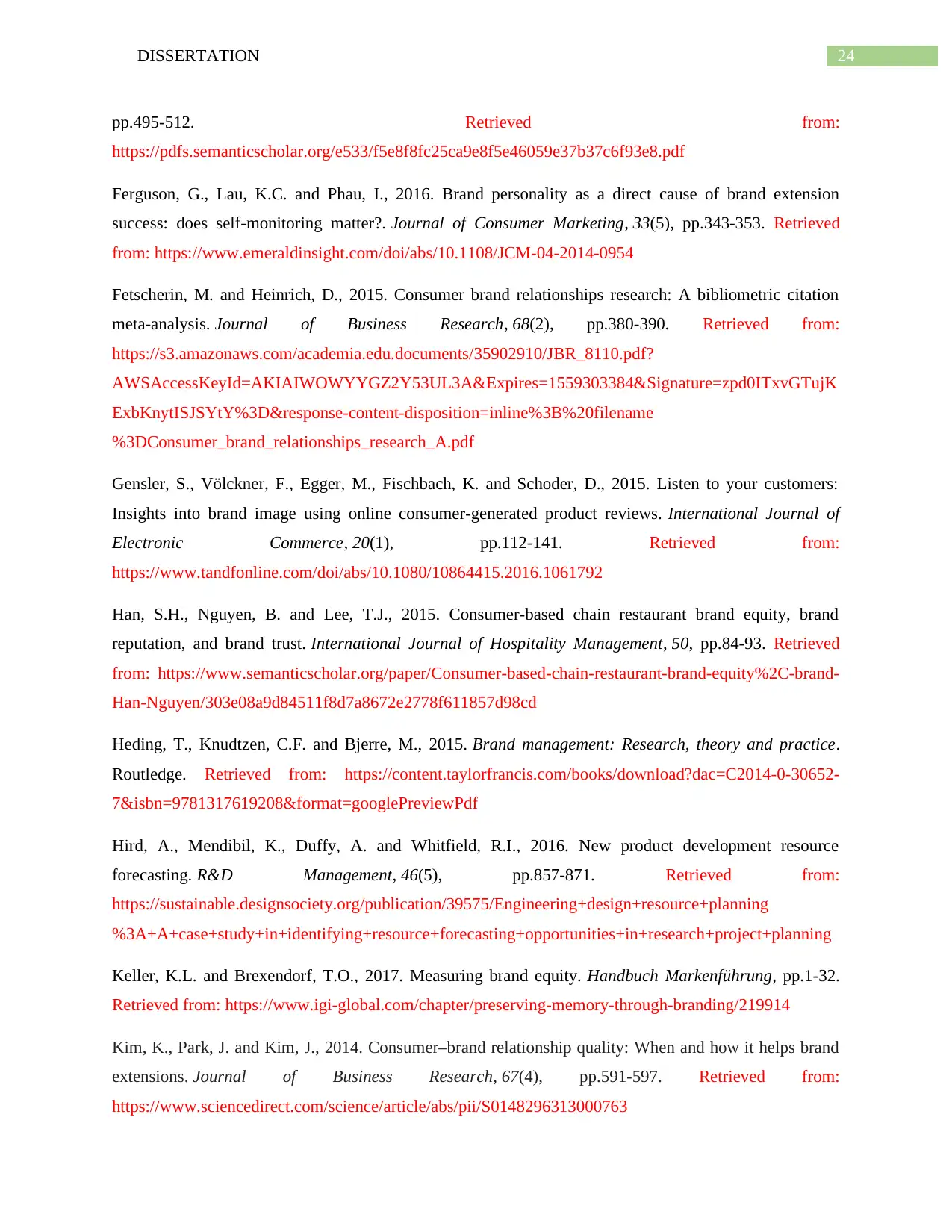
24DISSERTATION
pp.495-512. Retrieved from:
https://pdfs.semanticscholar.org/e533/f5e8f8fc25ca9e8f5e46059e37b37c6f93e8.pdf
Ferguson, G., Lau, K.C. and Phau, I., 2016. Brand personality as a direct cause of brand extension
success: does self-monitoring matter?. Journal of Consumer Marketing, 33(5), pp.343-353. Retrieved
from: https://www.emeraldinsight.com/doi/abs/10.1108/JCM-04-2014-0954
Fetscherin, M. and Heinrich, D., 2015. Consumer brand relationships research: A bibliometric citation
meta-analysis. Journal of Business Research, 68(2), pp.380-390. Retrieved from:
https://s3.amazonaws.com/academia.edu.documents/35902910/JBR_8110.pdf?
AWSAccessKeyId=AKIAIWOWYYGZ2Y53UL3A&Expires=1559303384&Signature=zpd0ITxvGTujK
ExbKnytISJSYtY%3D&response-content-disposition=inline%3B%20filename
%3DConsumer_brand_relationships_research_A.pdf
Gensler, S., Völckner, F., Egger, M., Fischbach, K. and Schoder, D., 2015. Listen to your customers:
Insights into brand image using online consumer-generated product reviews. International Journal of
Electronic Commerce, 20(1), pp.112-141. Retrieved from:
https://www.tandfonline.com/doi/abs/10.1080/10864415.2016.1061792
Han, S.H., Nguyen, B. and Lee, T.J., 2015. Consumer-based chain restaurant brand equity, brand
reputation, and brand trust. International Journal of Hospitality Management, 50, pp.84-93. Retrieved
from: https://www.semanticscholar.org/paper/Consumer-based-chain-restaurant-brand-equity%2C-brand-
Han-Nguyen/303e08a9d84511f8d7a8672e2778f611857d98cd
Heding, T., Knudtzen, C.F. and Bjerre, M., 2015. Brand management: Research, theory and practice.
Routledge. Retrieved from: https://content.taylorfrancis.com/books/download?dac=C2014-0-30652-
7&isbn=9781317619208&format=googlePreviewPdf
Hird, A., Mendibil, K., Duffy, A. and Whitfield, R.I., 2016. New product development resource
forecasting. R&D Management, 46(5), pp.857-871. Retrieved from:
https://sustainable.designsociety.org/publication/39575/Engineering+design+resource+planning
%3A+A+case+study+in+identifying+resource+forecasting+opportunities+in+research+project+planning
Keller, K.L. and Brexendorf, T.O., 2017. Measuring brand equity. Handbuch Markenführung, pp.1-32.
Retrieved from: https://www.igi-global.com/chapter/preserving-memory-through-branding/219914
Kim, K., Park, J. and Kim, J., 2014. Consumer–brand relationship quality: When and how it helps brand
extensions. Journal of Business Research, 67(4), pp.591-597. Retrieved from:
https://www.sciencedirect.com/science/article/abs/pii/S0148296313000763
pp.495-512. Retrieved from:
https://pdfs.semanticscholar.org/e533/f5e8f8fc25ca9e8f5e46059e37b37c6f93e8.pdf
Ferguson, G., Lau, K.C. and Phau, I., 2016. Brand personality as a direct cause of brand extension
success: does self-monitoring matter?. Journal of Consumer Marketing, 33(5), pp.343-353. Retrieved
from: https://www.emeraldinsight.com/doi/abs/10.1108/JCM-04-2014-0954
Fetscherin, M. and Heinrich, D., 2015. Consumer brand relationships research: A bibliometric citation
meta-analysis. Journal of Business Research, 68(2), pp.380-390. Retrieved from:
https://s3.amazonaws.com/academia.edu.documents/35902910/JBR_8110.pdf?
AWSAccessKeyId=AKIAIWOWYYGZ2Y53UL3A&Expires=1559303384&Signature=zpd0ITxvGTujK
ExbKnytISJSYtY%3D&response-content-disposition=inline%3B%20filename
%3DConsumer_brand_relationships_research_A.pdf
Gensler, S., Völckner, F., Egger, M., Fischbach, K. and Schoder, D., 2015. Listen to your customers:
Insights into brand image using online consumer-generated product reviews. International Journal of
Electronic Commerce, 20(1), pp.112-141. Retrieved from:
https://www.tandfonline.com/doi/abs/10.1080/10864415.2016.1061792
Han, S.H., Nguyen, B. and Lee, T.J., 2015. Consumer-based chain restaurant brand equity, brand
reputation, and brand trust. International Journal of Hospitality Management, 50, pp.84-93. Retrieved
from: https://www.semanticscholar.org/paper/Consumer-based-chain-restaurant-brand-equity%2C-brand-
Han-Nguyen/303e08a9d84511f8d7a8672e2778f611857d98cd
Heding, T., Knudtzen, C.F. and Bjerre, M., 2015. Brand management: Research, theory and practice.
Routledge. Retrieved from: https://content.taylorfrancis.com/books/download?dac=C2014-0-30652-
7&isbn=9781317619208&format=googlePreviewPdf
Hird, A., Mendibil, K., Duffy, A. and Whitfield, R.I., 2016. New product development resource
forecasting. R&D Management, 46(5), pp.857-871. Retrieved from:
https://sustainable.designsociety.org/publication/39575/Engineering+design+resource+planning
%3A+A+case+study+in+identifying+resource+forecasting+opportunities+in+research+project+planning
Keller, K.L. and Brexendorf, T.O., 2017. Measuring brand equity. Handbuch Markenführung, pp.1-32.
Retrieved from: https://www.igi-global.com/chapter/preserving-memory-through-branding/219914
Kim, K., Park, J. and Kim, J., 2014. Consumer–brand relationship quality: When and how it helps brand
extensions. Journal of Business Research, 67(4), pp.591-597. Retrieved from:
https://www.sciencedirect.com/science/article/abs/pii/S0148296313000763
Paraphrase This Document
Need a fresh take? Get an instant paraphrase of this document with our AI Paraphraser
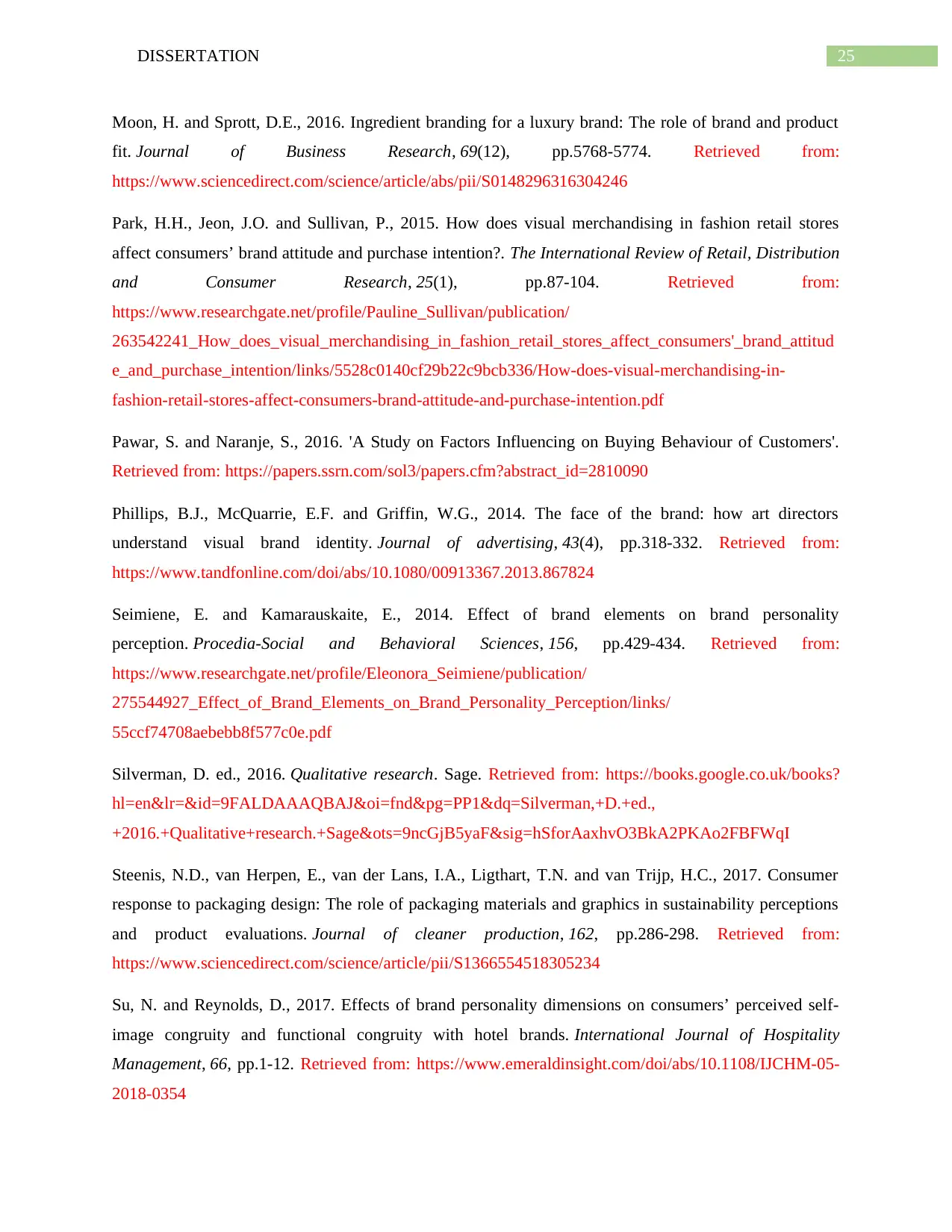
25DISSERTATION
Moon, H. and Sprott, D.E., 2016. Ingredient branding for a luxury brand: The role of brand and product
fit. Journal of Business Research, 69(12), pp.5768-5774. Retrieved from:
https://www.sciencedirect.com/science/article/abs/pii/S0148296316304246
Park, H.H., Jeon, J.O. and Sullivan, P., 2015. How does visual merchandising in fashion retail stores
affect consumers’ brand attitude and purchase intention?. The International Review of Retail, Distribution
and Consumer Research, 25(1), pp.87-104. Retrieved from:
https://www.researchgate.net/profile/Pauline_Sullivan/publication/
263542241_How_does_visual_merchandising_in_fashion_retail_stores_affect_consumers'_brand_attitud
e_and_purchase_intention/links/5528c0140cf29b22c9bcb336/How-does-visual-merchandising-in-
fashion-retail-stores-affect-consumers-brand-attitude-and-purchase-intention.pdf
Pawar, S. and Naranje, S., 2016. 'A Study on Factors Influencing on Buying Behaviour of Customers'.
Retrieved from: https://papers.ssrn.com/sol3/papers.cfm?abstract_id=2810090
Phillips, B.J., McQuarrie, E.F. and Griffin, W.G., 2014. The face of the brand: how art directors
understand visual brand identity. Journal of advertising, 43(4), pp.318-332. Retrieved from:
https://www.tandfonline.com/doi/abs/10.1080/00913367.2013.867824
Seimiene, E. and Kamarauskaite, E., 2014. Effect of brand elements on brand personality
perception. Procedia-Social and Behavioral Sciences, 156, pp.429-434. Retrieved from:
https://www.researchgate.net/profile/Eleonora_Seimiene/publication/
275544927_Effect_of_Brand_Elements_on_Brand_Personality_Perception/links/
55ccf74708aebebb8f577c0e.pdf
Silverman, D. ed., 2016. Qualitative research. Sage. Retrieved from: https://books.google.co.uk/books?
hl=en&lr=&id=9FALDAAAQBAJ&oi=fnd&pg=PP1&dq=Silverman,+D.+ed.,
+2016.+Qualitative+research.+Sage&ots=9ncGjB5yaF&sig=hSforAaxhvO3BkA2PKAo2FBFWqI
Steenis, N.D., van Herpen, E., van der Lans, I.A., Ligthart, T.N. and van Trijp, H.C., 2017. Consumer
response to packaging design: The role of packaging materials and graphics in sustainability perceptions
and product evaluations. Journal of cleaner production, 162, pp.286-298. Retrieved from:
https://www.sciencedirect.com/science/article/pii/S1366554518305234
Su, N. and Reynolds, D., 2017. Effects of brand personality dimensions on consumers’ perceived self-
image congruity and functional congruity with hotel brands. International Journal of Hospitality
Management, 66, pp.1-12. Retrieved from: https://www.emeraldinsight.com/doi/abs/10.1108/IJCHM-05-
2018-0354
Moon, H. and Sprott, D.E., 2016. Ingredient branding for a luxury brand: The role of brand and product
fit. Journal of Business Research, 69(12), pp.5768-5774. Retrieved from:
https://www.sciencedirect.com/science/article/abs/pii/S0148296316304246
Park, H.H., Jeon, J.O. and Sullivan, P., 2015. How does visual merchandising in fashion retail stores
affect consumers’ brand attitude and purchase intention?. The International Review of Retail, Distribution
and Consumer Research, 25(1), pp.87-104. Retrieved from:
https://www.researchgate.net/profile/Pauline_Sullivan/publication/
263542241_How_does_visual_merchandising_in_fashion_retail_stores_affect_consumers'_brand_attitud
e_and_purchase_intention/links/5528c0140cf29b22c9bcb336/How-does-visual-merchandising-in-
fashion-retail-stores-affect-consumers-brand-attitude-and-purchase-intention.pdf
Pawar, S. and Naranje, S., 2016. 'A Study on Factors Influencing on Buying Behaviour of Customers'.
Retrieved from: https://papers.ssrn.com/sol3/papers.cfm?abstract_id=2810090
Phillips, B.J., McQuarrie, E.F. and Griffin, W.G., 2014. The face of the brand: how art directors
understand visual brand identity. Journal of advertising, 43(4), pp.318-332. Retrieved from:
https://www.tandfonline.com/doi/abs/10.1080/00913367.2013.867824
Seimiene, E. and Kamarauskaite, E., 2014. Effect of brand elements on brand personality
perception. Procedia-Social and Behavioral Sciences, 156, pp.429-434. Retrieved from:
https://www.researchgate.net/profile/Eleonora_Seimiene/publication/
275544927_Effect_of_Brand_Elements_on_Brand_Personality_Perception/links/
55ccf74708aebebb8f577c0e.pdf
Silverman, D. ed., 2016. Qualitative research. Sage. Retrieved from: https://books.google.co.uk/books?
hl=en&lr=&id=9FALDAAAQBAJ&oi=fnd&pg=PP1&dq=Silverman,+D.+ed.,
+2016.+Qualitative+research.+Sage&ots=9ncGjB5yaF&sig=hSforAaxhvO3BkA2PKAo2FBFWqI
Steenis, N.D., van Herpen, E., van der Lans, I.A., Ligthart, T.N. and van Trijp, H.C., 2017. Consumer
response to packaging design: The role of packaging materials and graphics in sustainability perceptions
and product evaluations. Journal of cleaner production, 162, pp.286-298. Retrieved from:
https://www.sciencedirect.com/science/article/pii/S1366554518305234
Su, N. and Reynolds, D., 2017. Effects of brand personality dimensions on consumers’ perceived self-
image congruity and functional congruity with hotel brands. International Journal of Hospitality
Management, 66, pp.1-12. Retrieved from: https://www.emeraldinsight.com/doi/abs/10.1108/IJCHM-05-
2018-0354
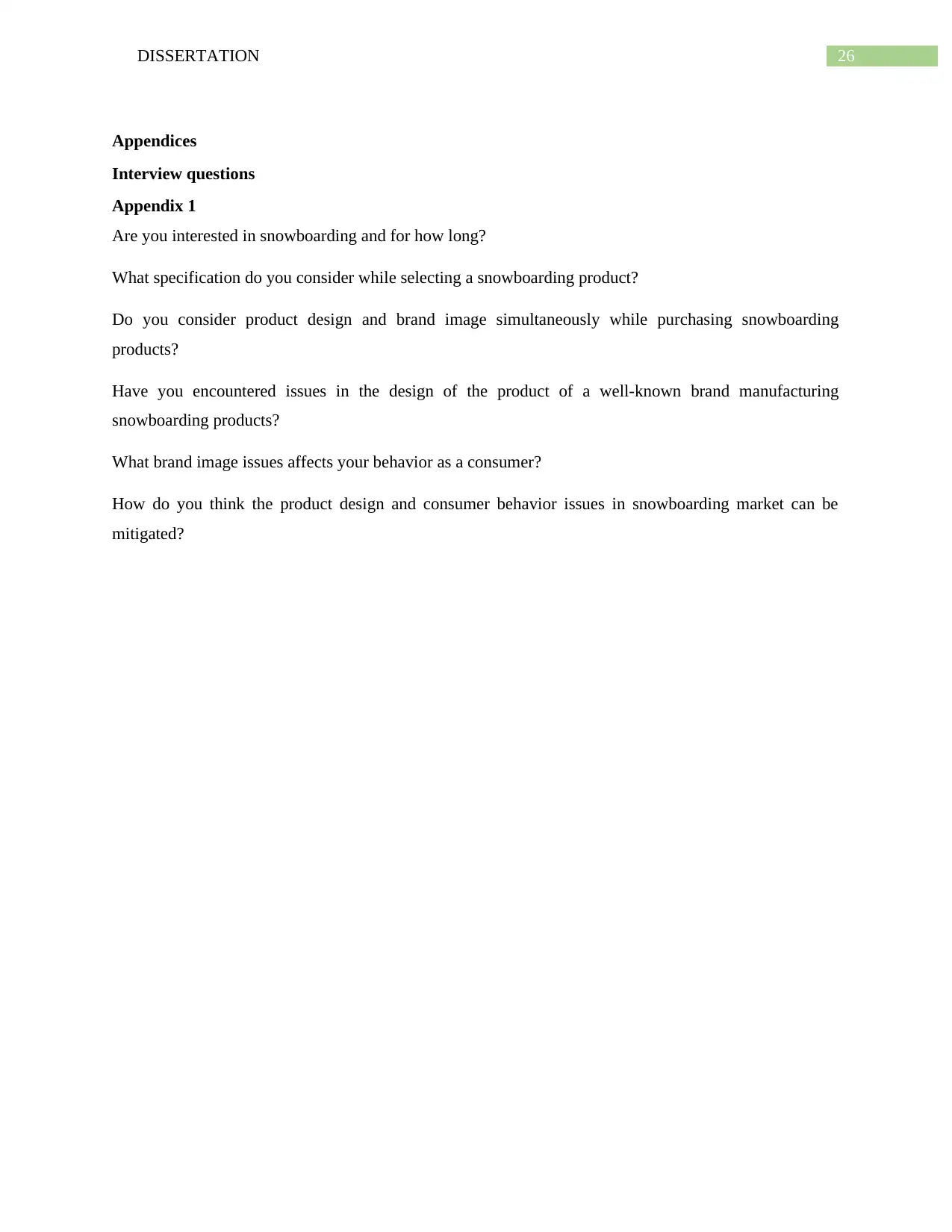
26DISSERTATION
Appendices
Interview questions
Appendix 1
Are you interested in snowboarding and for how long?
What specification do you consider while selecting a snowboarding product?
Do you consider product design and brand image simultaneously while purchasing snowboarding
products?
Have you encountered issues in the design of the product of a well-known brand manufacturing
snowboarding products?
What brand image issues affects your behavior as a consumer?
How do you think the product design and consumer behavior issues in snowboarding market can be
mitigated?
Appendices
Interview questions
Appendix 1
Are you interested in snowboarding and for how long?
What specification do you consider while selecting a snowboarding product?
Do you consider product design and brand image simultaneously while purchasing snowboarding
products?
Have you encountered issues in the design of the product of a well-known brand manufacturing
snowboarding products?
What brand image issues affects your behavior as a consumer?
How do you think the product design and consumer behavior issues in snowboarding market can be
mitigated?
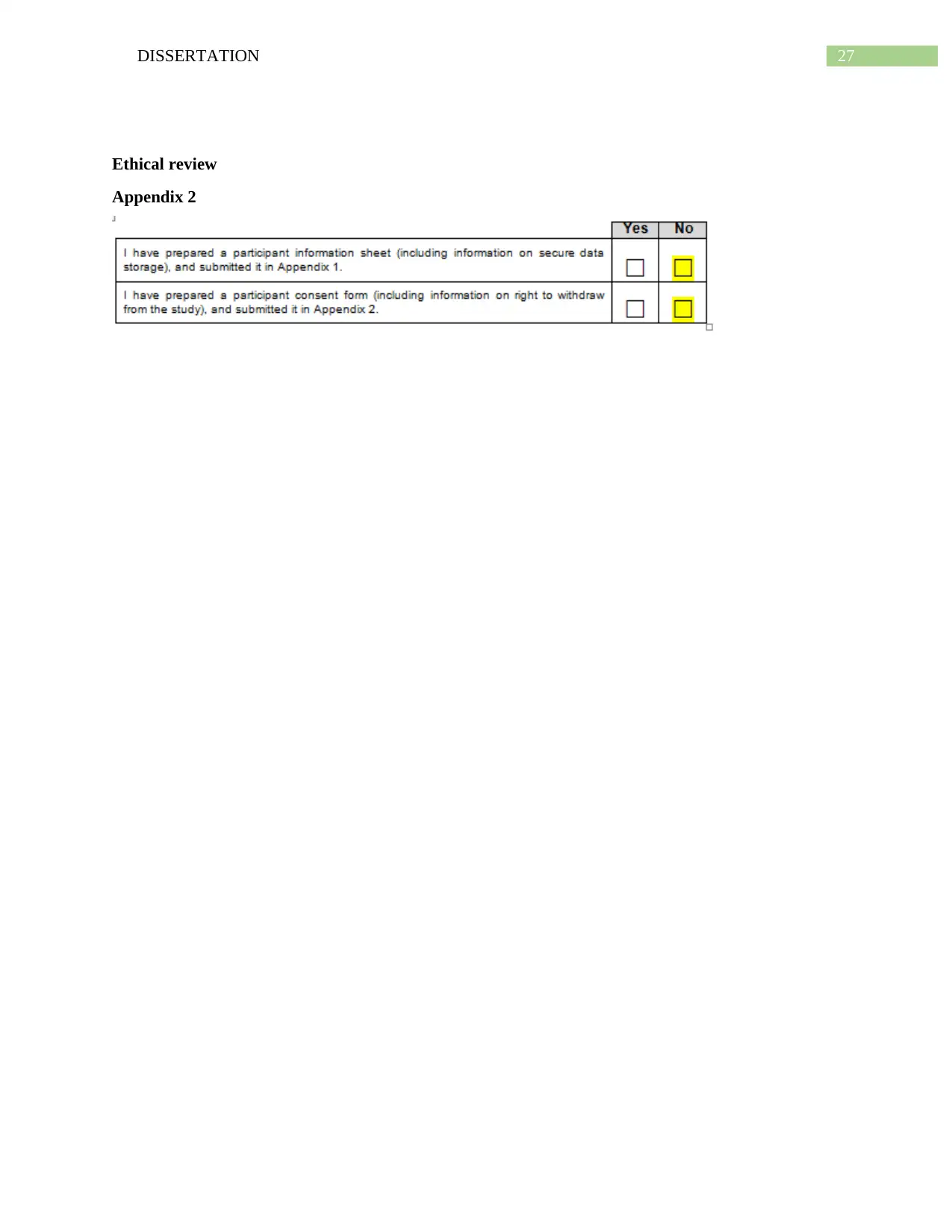
27DISSERTATION
Ethical review
Appendix 2
Ethical review
Appendix 2
Secure Best Marks with AI Grader
Need help grading? Try our AI Grader for instant feedback on your assignments.
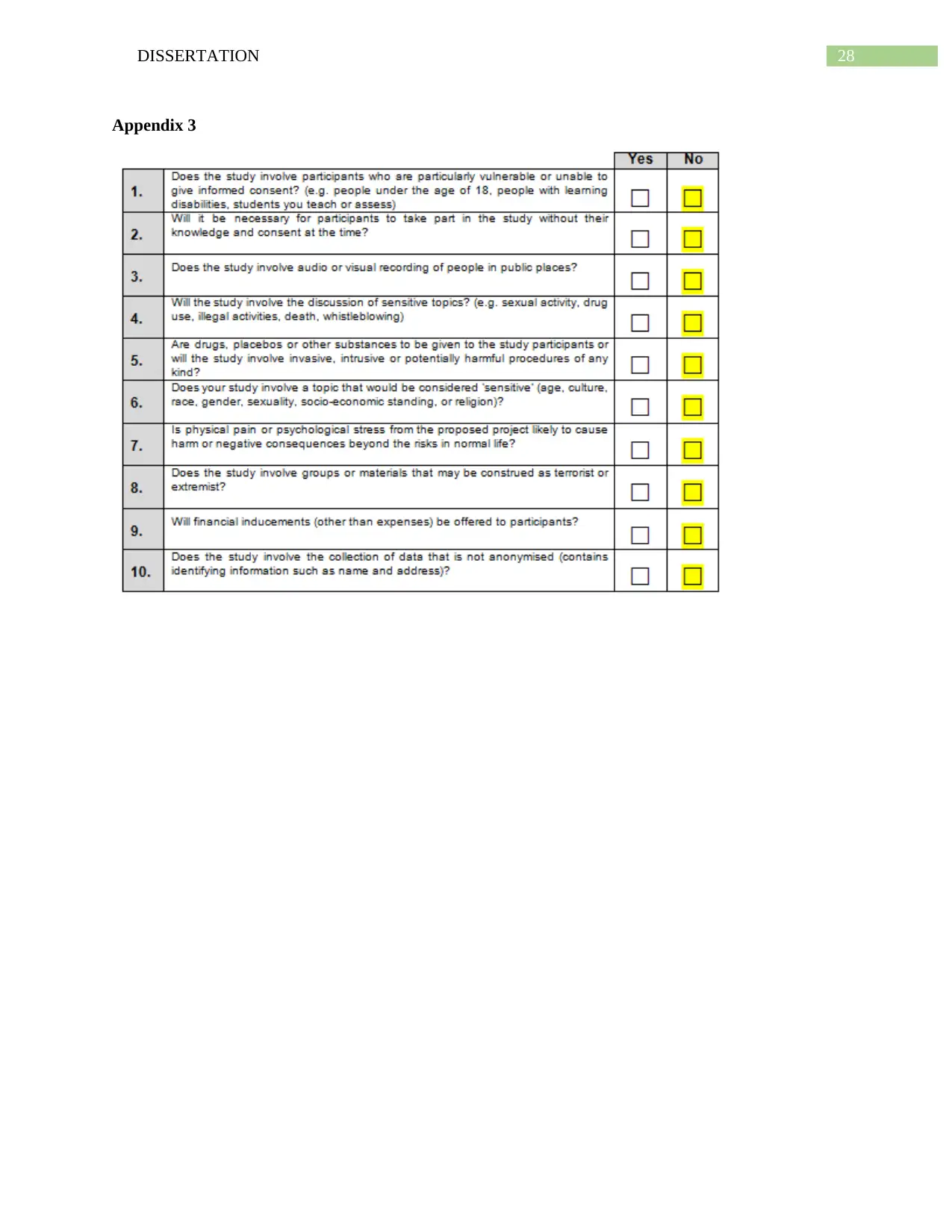
28DISSERTATION
Appendix 3
Appendix 3
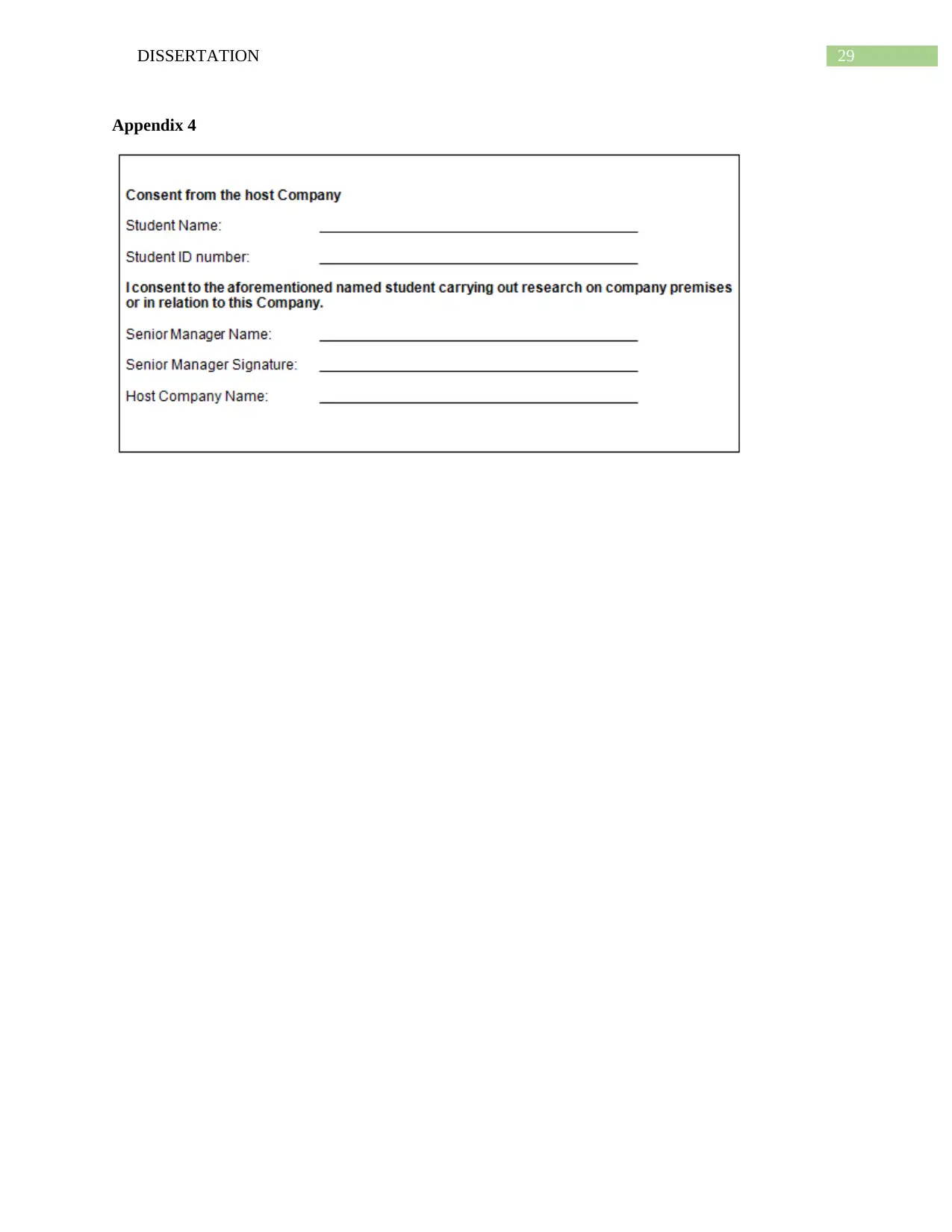
29DISSERTATION
Appendix 4
Appendix 4
1 out of 30
Related Documents
Your All-in-One AI-Powered Toolkit for Academic Success.
+13062052269
info@desklib.com
Available 24*7 on WhatsApp / Email
![[object Object]](/_next/static/media/star-bottom.7253800d.svg)
Unlock your academic potential
© 2024 | Zucol Services PVT LTD | All rights reserved.





